Paul van Yperen's Blog, page 366
October 24, 2015
Annie Girardot
French star Annie Girardot (1931-2011) was a sympathetic, perky, and talented actress. With her typical gravelly voice she appeared in many French and Italian quality films of the 1960s and 1970s. Unforgettable is her role as the tragic prostitute Nadia in Visconti’s classic Rocco e i suoi fratelli (1960), loved by two brothers played by Alain Delon and Renato Salvatori.
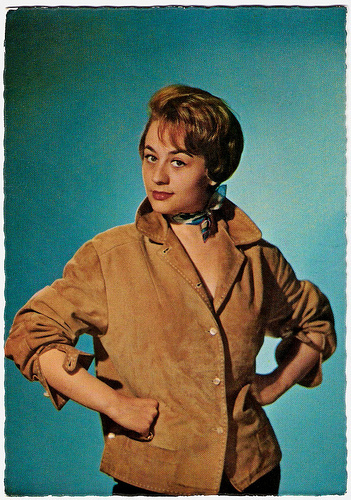
French postcard by Ed. EDUG, Paris. Photo: Sam Lévin.
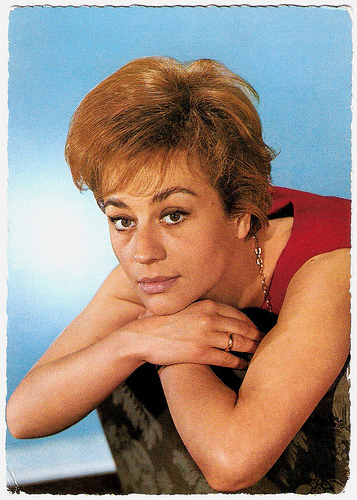
French postcard.
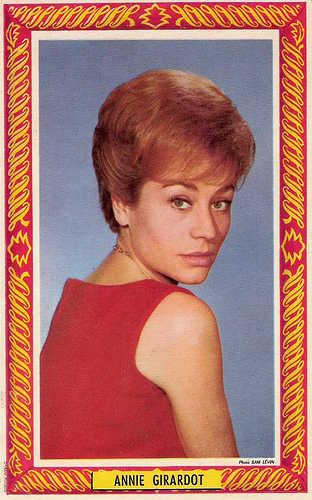
French postcard by St. Anne, Marseille. Photo: Sam Lévin.
Need to Take Risks and Experiment
Annie Suzanne Girardot was born in 1931, in Paris, France. In 1954 she graduated with honours from the Conservatoire de la rue Blanche (the Paris conservatory). That year she made her professional debut with the distinguished Comédie-Francaise.
Her performance in Jean Cocteau’s La Machine à écrire in 1956, opposite Robert Hirsch, was admired by the author who called her “The finest dramatic temperament of the postwar period”. She remained with the Comédie-Francaise troupe through 1957, occasionally taking time off to perform in films, on radio, television and in Parisian cabarets and revues.
Her inability to contain her need to take risks and experiment within the rigid dictates of the Comédie propelled Girardot toward the cinema. She had made an inauspicious film debut in the comedy Treize à table/Thirteen at the Table (André Hunebelle, 1955). The following year she won the Prix Suzanne Bianchetti for her role as a blackmailing vamp opposite Pierre Fresnay in L'homme aux clés d'or/The Man With the Golden Keys (Léo Joannon, 1956). In her early film roles, Girardot was typically cast as a doomed woman of dubious morals in dark films like Le rouge est mis/The red Light is On (Gilles Grangier, 1957) and Maigret tend un piège/Maigret Lays a Trap (Jean Delannoy, 1957), both starring Jean Gabin .
On stage she worked with famous director Luchino Visconti in Deux sur la balançoire/Two for the Seesaw (1958), at the side of Jean Marais . In the cinema she finally had her breakthrough when she played Nadia the prostitute in Visconti's epic family drama Rocco e i suoi fratelli/Rocco and His Brothers (Luchino Visconti, 1960). Nadia's beauty drives a wedge between Rocco ( Alain Delon ) and his brother Simone ( Renato Salvatori ), who eventually rapes her and stabs her thirteen times. Her depiction of the reformed prostitute suffering in her humiliation was both poignant and compelling.
During filming Girardot and Salvatori became romantically linked and they married in 1962. The couple later separated, but never divorced. In 1988 Salvatori died. Their daughter is Giulia Salvatori (1962).
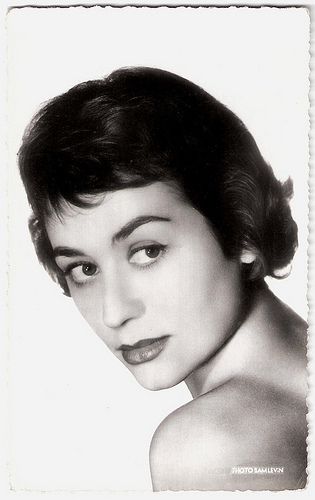
French postcard by Editions du Globe, Paris, no 611. Photo: Sam Lévin.
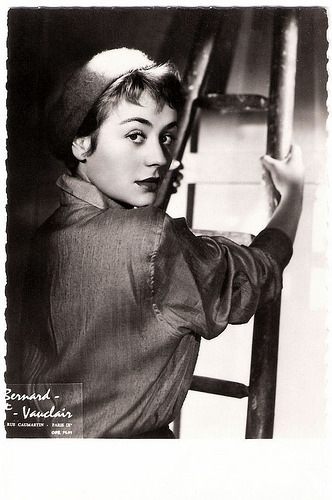
French postcard by Editions P.I., Paris, no. 851. Photo: Bernard-Vauclair, Paris.
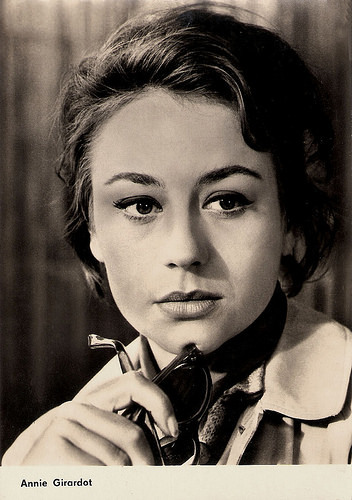
East-German postcard by VEB Progress Filmvertrieb, Berlin, no. 1696, 1962. Photo: publicity still for Rocco e i suoi fratelli/Rocco and his brothers (Luchino Visconti, 1960).
Dad's cinema
Through the early 1960s, Annie Girardot never worked with the young directors of the Nouvelle Vague, by whom she was seen as the actress of the Cinéma de Papa (Dad's cinema). And indeed she worked regularly with older directors like Christian-Jaque in La Française et l'Amour/Love and the Frenchwoman (1960), and Guerre secrète/The Dirty Game (1965) and Marcel Carné in Trois chambres à Manhattan/Three Rooms in Manhattan (1965). For her role in the latter film as the neurotic Kay discovering love, she won the Best Actress award at the Venice Film Festival.
She also played leads in Italian pictures directed by Marco Ferreri likeLa donna scimmia/The Ape Woman (1963), Il seme dell'uomo/The Seed of Man (1969), and Dillinger è morto/Dillinger Is Dead (1969), Mario Monicelli in I compagni/The Organizer (1963), Duccio Tessari in Una voglia da morire (1964) and again by Luchino Visconti in the anthology Le streghe/The Witches (1966).
Girardot became a box office magnet in France with Vivre pour vivre/Live for Life (Claude Lelouch, 1967). She gave a reserved, dignified performance as the deceived but forgiving wife of Yves Montand . Another big hit was the sentimental melodrama Un homme qui me plaît/A Man I Like (Claude Lelouch, 1969) in which she was the vivacious Françoise destined to finish unhappily with Jean-Paul Belmondo .
In the 1970s, Girardot was one of the most popular stars of the French cinema, associated with the directors Lelouch, Philippe de Broca, and André Cayatte, and with actor Philippe Noiret . Her biggest international hit was the fact-based tale Mourir d'aimer/Death of Love (André Cayatte, 1971) about the Gabrielle Russier affair. Very convincingly she played the middle-aged literature teacher who was accused of corrupting a minor, one of her students with whom she had an affair, and who, out of despair, committed suicide in jail. In the late 1960s the affair had become a much debated subject, even president Georges Pompidou referred to it. The film was nominated for a Golden Globe.
Each new film of ‘La Girardot’ was eagerly awaited for. Girardot typically played strong-willed, independent, hard-working, and often lonely women, giving her characters an earthiness and reality that endeared her with women undergoing similar daily struggles. Girardot became thus one of the symbols of the early-'70s feminist movement in France - though in personal life Girardot was not terribly involved with feminists.
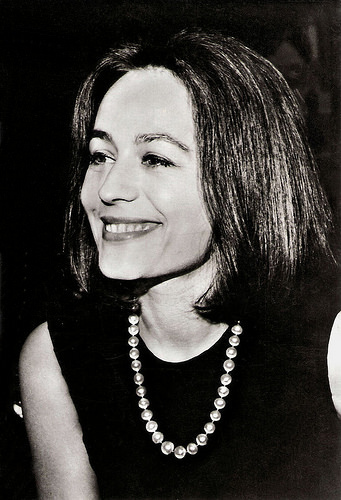
Romanian postcard by Casa Filmului Acin.
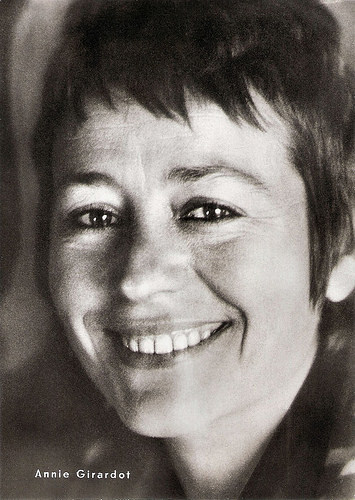
East-German postcard by Progress Filmverleih, Berlin, no. 64/79, 1979.
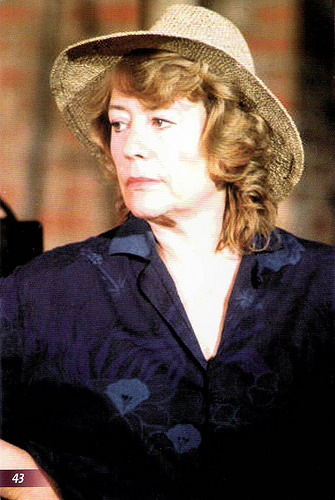
French postcard by Editions Atlas, Evreux, no. 43. Photo: publicity still for the TV Mini-Series Le Vent des Moissons/The Wind of Harvest (Jean Sagols, 1988).
Adept Comedienne
Annie Girardot started to play mother roles of young stars like Claude Jade in Les feux de la Chandeleur/Hearth Fires (Serge Korber, 1972) or Isabelle Adjani in La gifle/The Slap (Claude Pinoteau, 1974). She played Isabelle Huppert 's mother in two films: Docteur Françoise Gailland/No Time for Breakfast (Jean-Louis Bertucelli, 1975) and La pianiste/The Piano Teacher (Michael Haneke, 2001).
For portraying the title character in Docteur Françoise Gailland she won the César, the French Oscar, for Best Actress in 1977. Though she gave solid performances in many dramas, Girardot proved herself also an adept comedienne in such films as La vielle fille/The Old Maid (Jean-Pierre Blanc, 1972), Tendre Poulet/Dear Inspector (Philippe de Broca, 1977), La zizanie/The Spat (Claude Zidi, 1978) and L'ingorgo - Una storia impossibile/Traffic Jam (Luigi Comencini, 1979). Her success as the female detective Lise Tanquerelle, comically caught between personal and professional roles, in Tendre Poulet led to the sequel On a volé la cuisse de Jupiter/Jupiter's Thigh (Philippe de Broca, 1980).
She also helped young film directors making their first films. On stage she had a triumph in 1974 with Madame Marguerite, her signature role, which she reprised many times till 2002. That year she was awarded the Molière award for her role.
By the 1980s, her cinema career was in sharp decline and her film appearances became sporadic. She published her autobiography Vivre d'aimer in 1989, followed by Ma vie contre la tienne in 1993. However, in 1995 she made a come-back playing a peasant wife in Les Misérables (Claude Lelouch, 1995). The role won her a Cesar for Best Supporting Actress. Upon accepting the award, a joyous and tearful Girardot expressed her happiness that she had not been forgotten. She also offered her heartfelt thanks to her many film industry colleagues.
In 2002, she was again awarded this award for her role as the nightmarish mother in La pianiste/The Piano Player (Michael Haneke, 2002). She collaborated with Austrian director Haneke again, in Caché/Hidden (Michael Haneke, 2005) starring Juliette Binoche. In 2006
Annie Girardot revealed in magazine Paris Match that she was suffering since 2003 from Alzheimer's disease. The following year Giulia Salvatori published, with journalist Jean-Michel Caradec'h, the biography La Mémoire de ma mère about her mother. Annie Girardot appeared for the last time in the TV documentary Annie Girardot, ainsi va la vie/Annie Girardot, as life goes (2008). Since 2008, she lived in a sanatorium in Paris.
In 2011, Annie Girardot passed away. She was 79. At Flickr, Kay Harpa commemorated Annie: "Annie could make us laugh and cry - she was a beautiful lady full of generosity and interest for other people. She could be many women - she was the first feminine actress to play lawyer, surgeon, doctor,........ great parts they usually give to men. She had a beautiful and sensitive way of looking at people, things,...... her soul and heart were reflected in her beautiful brown eyes."
French trailer for Maigret tend un piège (1957). Source: lbena65 (YouTube).
Trailer for Rocco e i suoi fratelli/Rocco and His Brothers (1960). Source: Filmmuseum Amsterdam (YouTube).
Scene from La donna scimmia/The Ape Woman (1963). Source: Alex Settantasette (YouTube).
French trailer for Les Novices (1970) with Annie Girardot and Brigitte Bardot . Source: Modcinema (YouTube).
French language scene from Docteur Françoise Gailland (1976). Source: Romuald MAHLER-GLEY (YouTube).
Sources: Sandra Brennan (AllMovie), R. F. Cousins and Kelly Otter (Filmreference.com), (IMDb), Ephraim Katz (The Film Encylopedia), Wikipedia, and .

French postcard by Ed. EDUG, Paris. Photo: Sam Lévin.

French postcard.

French postcard by St. Anne, Marseille. Photo: Sam Lévin.
Need to Take Risks and Experiment
Annie Suzanne Girardot was born in 1931, in Paris, France. In 1954 she graduated with honours from the Conservatoire de la rue Blanche (the Paris conservatory). That year she made her professional debut with the distinguished Comédie-Francaise.
Her performance in Jean Cocteau’s La Machine à écrire in 1956, opposite Robert Hirsch, was admired by the author who called her “The finest dramatic temperament of the postwar period”. She remained with the Comédie-Francaise troupe through 1957, occasionally taking time off to perform in films, on radio, television and in Parisian cabarets and revues.
Her inability to contain her need to take risks and experiment within the rigid dictates of the Comédie propelled Girardot toward the cinema. She had made an inauspicious film debut in the comedy Treize à table/Thirteen at the Table (André Hunebelle, 1955). The following year she won the Prix Suzanne Bianchetti for her role as a blackmailing vamp opposite Pierre Fresnay in L'homme aux clés d'or/The Man With the Golden Keys (Léo Joannon, 1956). In her early film roles, Girardot was typically cast as a doomed woman of dubious morals in dark films like Le rouge est mis/The red Light is On (Gilles Grangier, 1957) and Maigret tend un piège/Maigret Lays a Trap (Jean Delannoy, 1957), both starring Jean Gabin .
On stage she worked with famous director Luchino Visconti in Deux sur la balançoire/Two for the Seesaw (1958), at the side of Jean Marais . In the cinema she finally had her breakthrough when she played Nadia the prostitute in Visconti's epic family drama Rocco e i suoi fratelli/Rocco and His Brothers (Luchino Visconti, 1960). Nadia's beauty drives a wedge between Rocco ( Alain Delon ) and his brother Simone ( Renato Salvatori ), who eventually rapes her and stabs her thirteen times. Her depiction of the reformed prostitute suffering in her humiliation was both poignant and compelling.
During filming Girardot and Salvatori became romantically linked and they married in 1962. The couple later separated, but never divorced. In 1988 Salvatori died. Their daughter is Giulia Salvatori (1962).

French postcard by Editions du Globe, Paris, no 611. Photo: Sam Lévin.

French postcard by Editions P.I., Paris, no. 851. Photo: Bernard-Vauclair, Paris.

East-German postcard by VEB Progress Filmvertrieb, Berlin, no. 1696, 1962. Photo: publicity still for Rocco e i suoi fratelli/Rocco and his brothers (Luchino Visconti, 1960).
Dad's cinema
Through the early 1960s, Annie Girardot never worked with the young directors of the Nouvelle Vague, by whom she was seen as the actress of the Cinéma de Papa (Dad's cinema). And indeed she worked regularly with older directors like Christian-Jaque in La Française et l'Amour/Love and the Frenchwoman (1960), and Guerre secrète/The Dirty Game (1965) and Marcel Carné in Trois chambres à Manhattan/Three Rooms in Manhattan (1965). For her role in the latter film as the neurotic Kay discovering love, she won the Best Actress award at the Venice Film Festival.
She also played leads in Italian pictures directed by Marco Ferreri likeLa donna scimmia/The Ape Woman (1963), Il seme dell'uomo/The Seed of Man (1969), and Dillinger è morto/Dillinger Is Dead (1969), Mario Monicelli in I compagni/The Organizer (1963), Duccio Tessari in Una voglia da morire (1964) and again by Luchino Visconti in the anthology Le streghe/The Witches (1966).
Girardot became a box office magnet in France with Vivre pour vivre/Live for Life (Claude Lelouch, 1967). She gave a reserved, dignified performance as the deceived but forgiving wife of Yves Montand . Another big hit was the sentimental melodrama Un homme qui me plaît/A Man I Like (Claude Lelouch, 1969) in which she was the vivacious Françoise destined to finish unhappily with Jean-Paul Belmondo .
In the 1970s, Girardot was one of the most popular stars of the French cinema, associated with the directors Lelouch, Philippe de Broca, and André Cayatte, and with actor Philippe Noiret . Her biggest international hit was the fact-based tale Mourir d'aimer/Death of Love (André Cayatte, 1971) about the Gabrielle Russier affair. Very convincingly she played the middle-aged literature teacher who was accused of corrupting a minor, one of her students with whom she had an affair, and who, out of despair, committed suicide in jail. In the late 1960s the affair had become a much debated subject, even president Georges Pompidou referred to it. The film was nominated for a Golden Globe.
Each new film of ‘La Girardot’ was eagerly awaited for. Girardot typically played strong-willed, independent, hard-working, and often lonely women, giving her characters an earthiness and reality that endeared her with women undergoing similar daily struggles. Girardot became thus one of the symbols of the early-'70s feminist movement in France - though in personal life Girardot was not terribly involved with feminists.

Romanian postcard by Casa Filmului Acin.

East-German postcard by Progress Filmverleih, Berlin, no. 64/79, 1979.

French postcard by Editions Atlas, Evreux, no. 43. Photo: publicity still for the TV Mini-Series Le Vent des Moissons/The Wind of Harvest (Jean Sagols, 1988).
Adept Comedienne
Annie Girardot started to play mother roles of young stars like Claude Jade in Les feux de la Chandeleur/Hearth Fires (Serge Korber, 1972) or Isabelle Adjani in La gifle/The Slap (Claude Pinoteau, 1974). She played Isabelle Huppert 's mother in two films: Docteur Françoise Gailland/No Time for Breakfast (Jean-Louis Bertucelli, 1975) and La pianiste/The Piano Teacher (Michael Haneke, 2001).
For portraying the title character in Docteur Françoise Gailland she won the César, the French Oscar, for Best Actress in 1977. Though she gave solid performances in many dramas, Girardot proved herself also an adept comedienne in such films as La vielle fille/The Old Maid (Jean-Pierre Blanc, 1972), Tendre Poulet/Dear Inspector (Philippe de Broca, 1977), La zizanie/The Spat (Claude Zidi, 1978) and L'ingorgo - Una storia impossibile/Traffic Jam (Luigi Comencini, 1979). Her success as the female detective Lise Tanquerelle, comically caught between personal and professional roles, in Tendre Poulet led to the sequel On a volé la cuisse de Jupiter/Jupiter's Thigh (Philippe de Broca, 1980).
She also helped young film directors making their first films. On stage she had a triumph in 1974 with Madame Marguerite, her signature role, which she reprised many times till 2002. That year she was awarded the Molière award for her role.
By the 1980s, her cinema career was in sharp decline and her film appearances became sporadic. She published her autobiography Vivre d'aimer in 1989, followed by Ma vie contre la tienne in 1993. However, in 1995 she made a come-back playing a peasant wife in Les Misérables (Claude Lelouch, 1995). The role won her a Cesar for Best Supporting Actress. Upon accepting the award, a joyous and tearful Girardot expressed her happiness that she had not been forgotten. She also offered her heartfelt thanks to her many film industry colleagues.
In 2002, she was again awarded this award for her role as the nightmarish mother in La pianiste/The Piano Player (Michael Haneke, 2002). She collaborated with Austrian director Haneke again, in Caché/Hidden (Michael Haneke, 2005) starring Juliette Binoche. In 2006
Annie Girardot revealed in magazine Paris Match that she was suffering since 2003 from Alzheimer's disease. The following year Giulia Salvatori published, with journalist Jean-Michel Caradec'h, the biography La Mémoire de ma mère about her mother. Annie Girardot appeared for the last time in the TV documentary Annie Girardot, ainsi va la vie/Annie Girardot, as life goes (2008). Since 2008, she lived in a sanatorium in Paris.
In 2011, Annie Girardot passed away. She was 79. At Flickr, Kay Harpa commemorated Annie: "Annie could make us laugh and cry - she was a beautiful lady full of generosity and interest for other people. She could be many women - she was the first feminine actress to play lawyer, surgeon, doctor,........ great parts they usually give to men. She had a beautiful and sensitive way of looking at people, things,...... her soul and heart were reflected in her beautiful brown eyes."
French trailer for Maigret tend un piège (1957). Source: lbena65 (YouTube).
Trailer for Rocco e i suoi fratelli/Rocco and His Brothers (1960). Source: Filmmuseum Amsterdam (YouTube).
Scene from La donna scimmia/The Ape Woman (1963). Source: Alex Settantasette (YouTube).
French trailer for Les Novices (1970) with Annie Girardot and Brigitte Bardot . Source: Modcinema (YouTube).
French language scene from Docteur Françoise Gailland (1976). Source: Romuald MAHLER-GLEY (YouTube).
Sources: Sandra Brennan (AllMovie), R. F. Cousins and Kelly Otter (Filmreference.com), (IMDb), Ephraim Katz (The Film Encylopedia), Wikipedia, and .
Published on October 24, 2015 23:00
October 23, 2015
Imported from the USA: Jean Seberg
American actress Jean Seberg (1938-1979) became an icon of the Nouvelle Vague with her role in Godard’s A Bout de Souffle/Breathless (1960). She appeared in over 30 films in Hollywood and Europe.
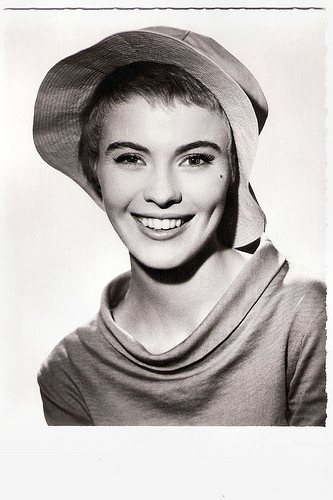
French postcard by Editions P.I., Paris, no. 900. Photo: Sam Lévin.

German postcard by WS-Druck, Wanne-Eickel, no. 334. Photo: Columbia / Filmpress Zürich.
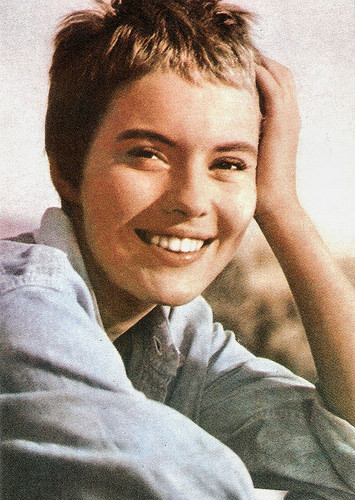
Romanian postcard by Casa Filmului Acin.
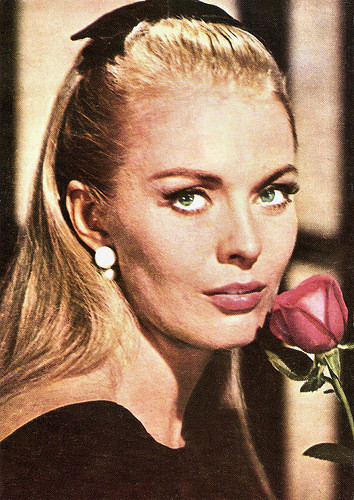
Romanian postcard by Casa Filmului Acin.
Breathless
Jean Dorothy Seberg was born in Marshalltown, Iowa, in 1938. Her parents were Dorothy Arline Benson, a substitute teacher, and her husband Edward Waldemar Seberg, a pharmacist. Her father was of Swedish descent and her mother was of English and German ancestry. Jean had a sister Mary-Ann, a brother Kurt, and a brother David, who was killed in a car accident in 1968.
One month before her eighteenth birthday, Jean landed the title role in Otto Preminger's Saint Joan (1957) after a much-publicized contest involving some 18,000 hopefuls. Her name was entered by a neighbour.
Her only acting experience had been a single season of summer stock performances. Saint Joan, based on the George Bernard Shaw play, was a failure.
Preminger had promised her a second chance, and he cast Seberg in his next film Bonjour Tristesse (1958), which was filmed in France. That film’s only moderate success and the atrocious reviews for Seberg nearly ended her career, but her next film, the comedy The Mouse That Roared (Jack Arnold, 1959) starring Peter Sellers, was a success.
During the filming of Bonjour Tristesse, Seberg met a young French lawyer with film abitions, François Moreuil. He became her first husband, and Jean based herself in France.
There she got her breakthrough role as Patricia in Jean-Luc Godard's landmark feature, À bout de soufflé/Breathless (1960), opposite Jean-Paul Belmondo . The film became an international success and critics praised Seberg's performance.
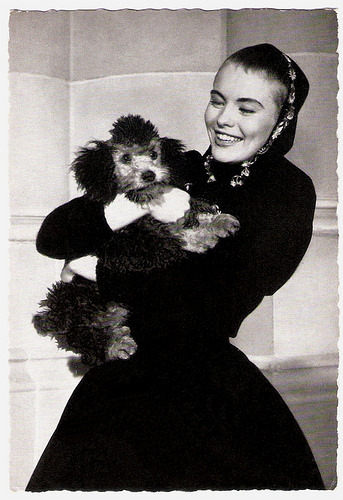
German postcard by WS-Druck, Wanne-Eickel, no. 195. Photo: dpa.
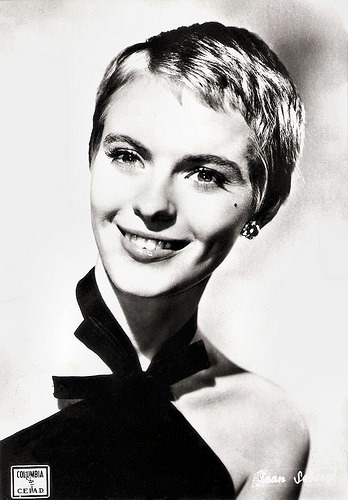
Italian postcard by Bromofoto, Milano, no. 1670. Photo: Columbia C.E.I.A.D.
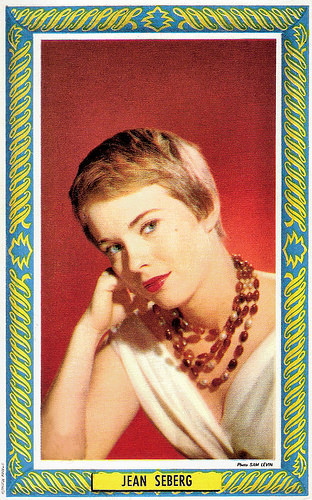
French postcard by St. Anne, Marseille. Photo: Sam Lévin.
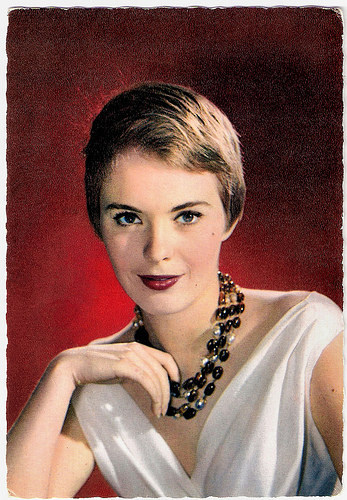
French postcard by E.D.U.G., Paris, no. 140. Photo: Sam Lévin.
Suicide
Jean Seberg was now an icon of the Nouvelle Vague, the French New Wave. She appeared in several French films, including Philippe De Broca's comedy-drama L'amant de cinq jours/Five Day Lover (1961). In 1961, she took on the lead role in her husband François Moreuil's debut film, La recreation/Love Play, with Christian Marquand.
She gave a memorable performance as a schizophrenic in the title role of Robert Rossen's Lilith (1964) opposite Warren Beatty. In 1969, she appeared in the Western musical Paint Your Wagon (Joshua Logan, 1969), based on Lerner and Loewe's stage musical, and co-starring Lee Marvin and Clint Eastwood . Her singing voice was dubbed by Anita Gordon.
Seberg also starred in the disaster film Airport (George Seaton, 1970) opposite Burt Lancaster and Dean Martin. The film earned nearly $ 100 million and originated the 1970s disaster film genre.
In the late 1960s, Seberg became involved in anti-war politics. Her involvement with the Black Panther movement yielded the attention of the FBI, that spread the rumour about her pregnancy in 1970 being a child by Raymond Hewt, a Black Panther movement leader. Although her husband Romain Gary acknowledged her daughter Nina as his own, during her pregnancy she confessed that her baby was actually the product of an affair (during a separation from Gary) with a revolutionary student named Carlos Navarra. Her daughter Nina died as a result of complications sustained from Jean overdosing on sleeping pills during her pregnancy, on 25 August 1970, two days after her birth. On every subsequent anniversary of Nina's death, Jean attempted suicide.
Seberg remained active during the 1970s in European films. She appeared in the thriller L'attentat/The Assassination (Yves Boisset, 1972) with Jean-Louis Trintignant , Bianchi cavalli d'Agosto /White Horses of Summer (Raimondo Del Balzo, 1975) with Frederick Stafford, Le Grand Délire/The Big Delirium (Dennis Berry, 1975), with Pierre Blaise and Isabelle Huppert, and Die Wildente/The Wild Duck (Hans W. Geissendörfer, 1976), based on Henrik Ibsen's The Wild Duck.
In 1979, Jean Seberg was found dead. She had committed suicide by a barbiturate overdose in the back seat of a car in a Paris suburb. Her body wasn't found until 11 days later. Rumours flew that Jean's suicide was masterminded by the FBI but it was never proven. Buried in the Montparnasse cemetery in Paris, her funeral was attended by such notables as Jean-Paul Sartre and Simone de Beauvoir.
Seberg was married four times. Her husbands were François Moreuil (1958-1960), the author Romain Gary (1962-1970), TV director Dennis Berry (1972-1978), and Algerian playboy Ahmed Hasni (1979–her death). With Gary, she had a son, Alexandre Diego Gary, born in 1962. In December 1980, Romain Gary committed suicide. Gary's suicide note, which was addressed to his publisher, indicated that he had not killed himself over the loss of Seberg but over the fact that he felt he could no longer produce literary works.
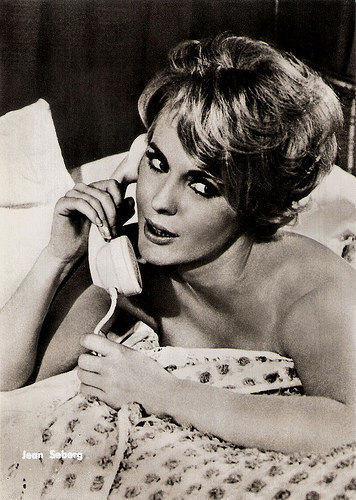
East-German postcard by VEB Progress Film-Vertrieb, Berlin, no. 155/71, 1971. Photo: publicity still for Un milliard dans un billard/Diamond Cue (Nicolas Gessner, 1965).
Trailer for Bonjour Tristesse (1958). Source: rosen88kavalier (YouTube).
Trailer for À bout de soufflé/Breathless (1960). Source: TheEnlightenGroup (YouTube).
Trailer for Philippe De Broca's L'amant de cinq jours/Five Day Lover (1961). Source: Cohen Film Collection (YouTube).
Sources: Wikipedia and .

French postcard by Editions P.I., Paris, no. 900. Photo: Sam Lévin.

German postcard by WS-Druck, Wanne-Eickel, no. 334. Photo: Columbia / Filmpress Zürich.

Romanian postcard by Casa Filmului Acin.

Romanian postcard by Casa Filmului Acin.
Breathless
Jean Dorothy Seberg was born in Marshalltown, Iowa, in 1938. Her parents were Dorothy Arline Benson, a substitute teacher, and her husband Edward Waldemar Seberg, a pharmacist. Her father was of Swedish descent and her mother was of English and German ancestry. Jean had a sister Mary-Ann, a brother Kurt, and a brother David, who was killed in a car accident in 1968.
One month before her eighteenth birthday, Jean landed the title role in Otto Preminger's Saint Joan (1957) after a much-publicized contest involving some 18,000 hopefuls. Her name was entered by a neighbour.
Her only acting experience had been a single season of summer stock performances. Saint Joan, based on the George Bernard Shaw play, was a failure.
Preminger had promised her a second chance, and he cast Seberg in his next film Bonjour Tristesse (1958), which was filmed in France. That film’s only moderate success and the atrocious reviews for Seberg nearly ended her career, but her next film, the comedy The Mouse That Roared (Jack Arnold, 1959) starring Peter Sellers, was a success.
During the filming of Bonjour Tristesse, Seberg met a young French lawyer with film abitions, François Moreuil. He became her first husband, and Jean based herself in France.
There she got her breakthrough role as Patricia in Jean-Luc Godard's landmark feature, À bout de soufflé/Breathless (1960), opposite Jean-Paul Belmondo . The film became an international success and critics praised Seberg's performance.

German postcard by WS-Druck, Wanne-Eickel, no. 195. Photo: dpa.

Italian postcard by Bromofoto, Milano, no. 1670. Photo: Columbia C.E.I.A.D.

French postcard by St. Anne, Marseille. Photo: Sam Lévin.

French postcard by E.D.U.G., Paris, no. 140. Photo: Sam Lévin.
Suicide
Jean Seberg was now an icon of the Nouvelle Vague, the French New Wave. She appeared in several French films, including Philippe De Broca's comedy-drama L'amant de cinq jours/Five Day Lover (1961). In 1961, she took on the lead role in her husband François Moreuil's debut film, La recreation/Love Play, with Christian Marquand.
She gave a memorable performance as a schizophrenic in the title role of Robert Rossen's Lilith (1964) opposite Warren Beatty. In 1969, she appeared in the Western musical Paint Your Wagon (Joshua Logan, 1969), based on Lerner and Loewe's stage musical, and co-starring Lee Marvin and Clint Eastwood . Her singing voice was dubbed by Anita Gordon.
Seberg also starred in the disaster film Airport (George Seaton, 1970) opposite Burt Lancaster and Dean Martin. The film earned nearly $ 100 million and originated the 1970s disaster film genre.
In the late 1960s, Seberg became involved in anti-war politics. Her involvement with the Black Panther movement yielded the attention of the FBI, that spread the rumour about her pregnancy in 1970 being a child by Raymond Hewt, a Black Panther movement leader. Although her husband Romain Gary acknowledged her daughter Nina as his own, during her pregnancy she confessed that her baby was actually the product of an affair (during a separation from Gary) with a revolutionary student named Carlos Navarra. Her daughter Nina died as a result of complications sustained from Jean overdosing on sleeping pills during her pregnancy, on 25 August 1970, two days after her birth. On every subsequent anniversary of Nina's death, Jean attempted suicide.
Seberg remained active during the 1970s in European films. She appeared in the thriller L'attentat/The Assassination (Yves Boisset, 1972) with Jean-Louis Trintignant , Bianchi cavalli d'Agosto /White Horses of Summer (Raimondo Del Balzo, 1975) with Frederick Stafford, Le Grand Délire/The Big Delirium (Dennis Berry, 1975), with Pierre Blaise and Isabelle Huppert, and Die Wildente/The Wild Duck (Hans W. Geissendörfer, 1976), based on Henrik Ibsen's The Wild Duck.
In 1979, Jean Seberg was found dead. She had committed suicide by a barbiturate overdose in the back seat of a car in a Paris suburb. Her body wasn't found until 11 days later. Rumours flew that Jean's suicide was masterminded by the FBI but it was never proven. Buried in the Montparnasse cemetery in Paris, her funeral was attended by such notables as Jean-Paul Sartre and Simone de Beauvoir.
Seberg was married four times. Her husbands were François Moreuil (1958-1960), the author Romain Gary (1962-1970), TV director Dennis Berry (1972-1978), and Algerian playboy Ahmed Hasni (1979–her death). With Gary, she had a son, Alexandre Diego Gary, born in 1962. In December 1980, Romain Gary committed suicide. Gary's suicide note, which was addressed to his publisher, indicated that he had not killed himself over the loss of Seberg but over the fact that he felt he could no longer produce literary works.

East-German postcard by VEB Progress Film-Vertrieb, Berlin, no. 155/71, 1971. Photo: publicity still for Un milliard dans un billard/Diamond Cue (Nicolas Gessner, 1965).
Trailer for Bonjour Tristesse (1958). Source: rosen88kavalier (YouTube).
Trailer for À bout de soufflé/Breathless (1960). Source: TheEnlightenGroup (YouTube).
Trailer for Philippe De Broca's L'amant de cinq jours/Five Day Lover (1961). Source: Cohen Film Collection (YouTube).
Sources: Wikipedia and .
Published on October 23, 2015 22:00
October 22, 2015
EFSP's Dazzling Dozen: Top Hats
New series alert at EFSP! During our trip to the Pordenone Silent Film Festival earlier this month, we did a post on twelve silent cowboys and liked the concept. So, last week we started a new series especially for Postcard Friendship Friday with a dozen star postcards with a theme. Last week it was stars with their dogs. Today we present you our twelve favourite postcards of stars wearing amazing hats.
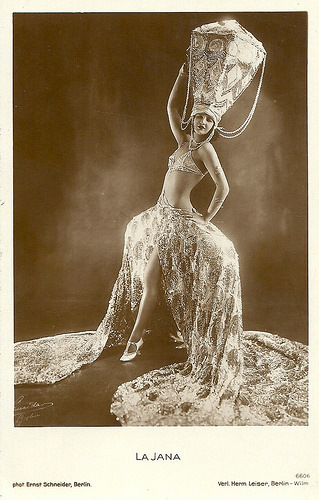
La Jana. German postcard by Verlag Hermann Leiser, Berlin-Wilm., no. 6606. Photo: Ernst Schneider, Berlin. Collection: Didier Hanson.
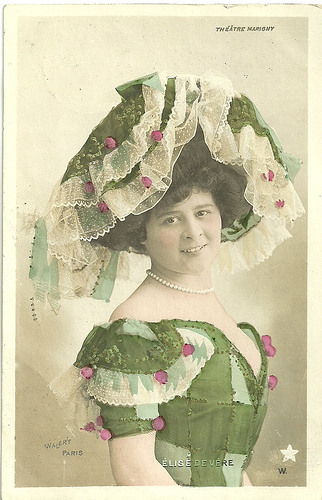
Elise de Vere. French postcard. Photo: Lucien Waléry, Paris.
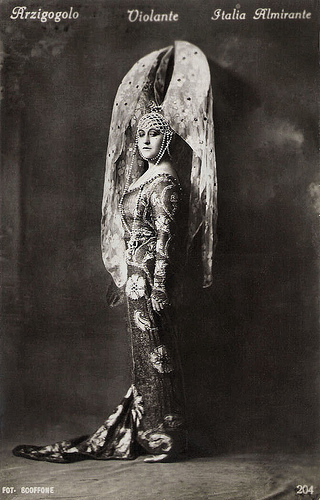
Italia Almirante Manzini . Italian postcard by Ballerini & Fratini, Firenze, no. 204. Photo Scoffone. Italia Almirante Manzini as Violante in the film L'Arzigogolo (Mario Almirante, 1924), adaptation of the play by Sem Benelli.
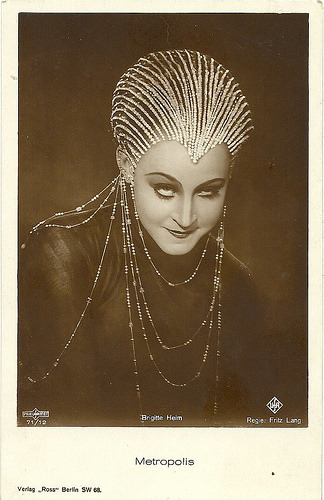
Brigitte Helm . German postcard by Ross Verlag, Berlin, no. 71/12. Photo: Ufa / Parufamet. Publicity still for Metropolis (Fritz Lang, 1927). Collection: Didier Hanson.
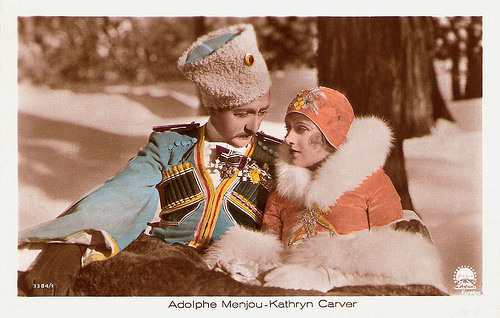
Adolphe Menjou and Kathryn Carver. British Real Hand-Coloured Photograph postcard, no. 3384/1. Photo: Paramount. Publicity still for Service for Ladies (Harry d'Abbadie d'Arrast, 1927).
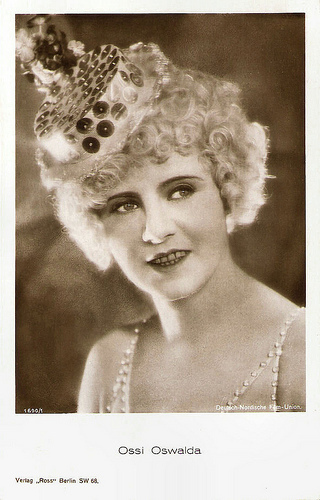
Ossi Oswalda . German postcard by Ross Verlag, no. 1690/1, 1927-1928. Photo: Deutsch-Nordische Film-Union.
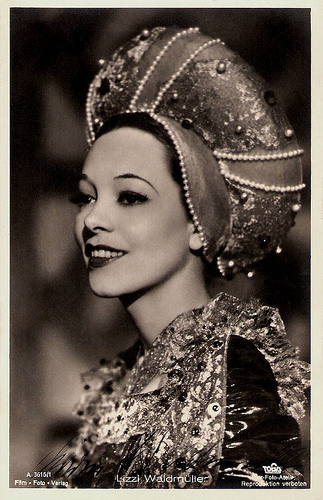
Lizzi Waldmüller . German postcard by Film-Foto-Verlag, no. A 3615/1, 1941-1944. Photo: Film-Foto-Atelier / Tobis.
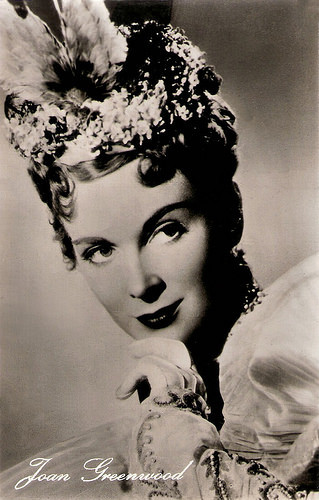
Joan Greenwood . East-German postcard by VEB Progress Film-Vertrieb, Berlin, no. 1068, 1959. Photo: J. Arthur Rank. Publicity still for The Importance of Being Earnest (Anthony Asquith, 1952).
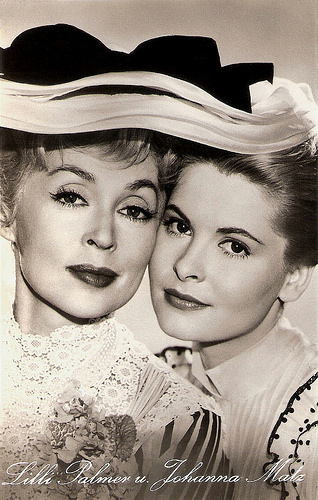
Lilli Palmer and Johanna Matz . East-German postcard by Progress, no. 1306, 1960. Photo: publicity still for Frau Warrens Gewerbe/Mrs. Warren's Profession (Ákos Ráthonyi, 1960).
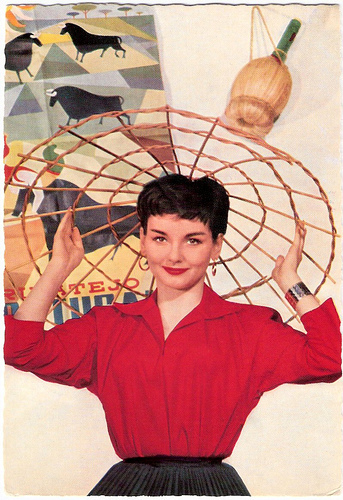
Ingrid Andree . German postcard by WS-Druck, Wanne-Eickel, nr. F 74. Photo: Ringpress.
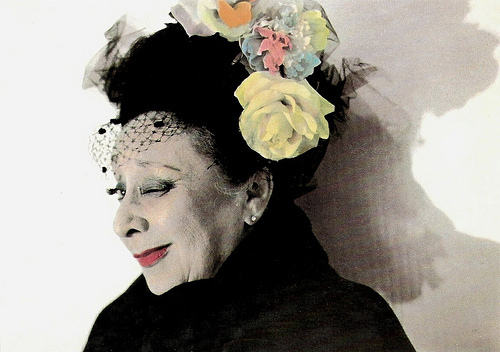
Lotti Huber . German postcard by Edition Wild, Waldbröl. Photo: Gertrude Garancy. Colouring: Cesa, 1990.
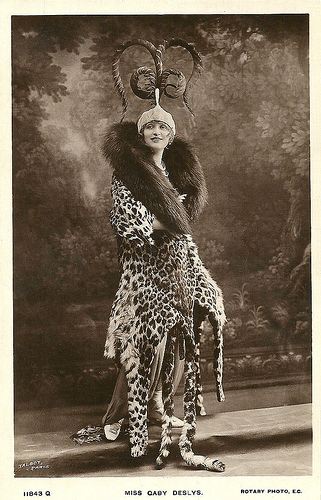
Gaby Deslys . British postcard by Rotary Photo, no. 11843 Q. Photo: Talbot, Paris. Collection: Didier Hanson.
This is a post for Postcard Friendship Friday, hosted by Beth at the blog The Best Hearts are Crunchy. You can visit her by clicking on the button below.


La Jana. German postcard by Verlag Hermann Leiser, Berlin-Wilm., no. 6606. Photo: Ernst Schneider, Berlin. Collection: Didier Hanson.

Elise de Vere. French postcard. Photo: Lucien Waléry, Paris.

Italia Almirante Manzini . Italian postcard by Ballerini & Fratini, Firenze, no. 204. Photo Scoffone. Italia Almirante Manzini as Violante in the film L'Arzigogolo (Mario Almirante, 1924), adaptation of the play by Sem Benelli.

Brigitte Helm . German postcard by Ross Verlag, Berlin, no. 71/12. Photo: Ufa / Parufamet. Publicity still for Metropolis (Fritz Lang, 1927). Collection: Didier Hanson.

Adolphe Menjou and Kathryn Carver. British Real Hand-Coloured Photograph postcard, no. 3384/1. Photo: Paramount. Publicity still for Service for Ladies (Harry d'Abbadie d'Arrast, 1927).

Ossi Oswalda . German postcard by Ross Verlag, no. 1690/1, 1927-1928. Photo: Deutsch-Nordische Film-Union.

Lizzi Waldmüller . German postcard by Film-Foto-Verlag, no. A 3615/1, 1941-1944. Photo: Film-Foto-Atelier / Tobis.

Joan Greenwood . East-German postcard by VEB Progress Film-Vertrieb, Berlin, no. 1068, 1959. Photo: J. Arthur Rank. Publicity still for The Importance of Being Earnest (Anthony Asquith, 1952).

Lilli Palmer and Johanna Matz . East-German postcard by Progress, no. 1306, 1960. Photo: publicity still for Frau Warrens Gewerbe/Mrs. Warren's Profession (Ákos Ráthonyi, 1960).

Ingrid Andree . German postcard by WS-Druck, Wanne-Eickel, nr. F 74. Photo: Ringpress.

Lotti Huber . German postcard by Edition Wild, Waldbröl. Photo: Gertrude Garancy. Colouring: Cesa, 1990.

Gaby Deslys . British postcard by Rotary Photo, no. 11843 Q. Photo: Talbot, Paris. Collection: Didier Hanson.
This is a post for Postcard Friendship Friday, hosted by Beth at the blog The Best Hearts are Crunchy. You can visit her by clicking on the button below.

Published on October 22, 2015 22:00
October 21, 2015
Lu L'Arronge
Little is known about Lu L'Arronge (1902-1991), who was a star of the German silent cinema, just after the First World War. The actress, who specialized in playing high-spirited teenagers, had her own production company with which she produced several films.
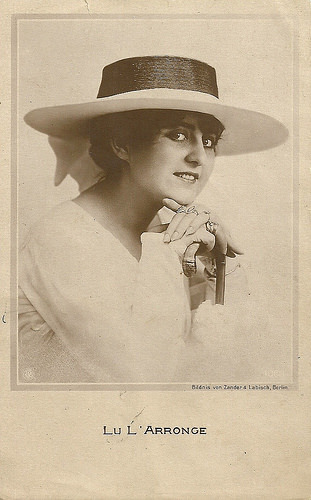
German postcard by Zander & Labisch, Berlin.
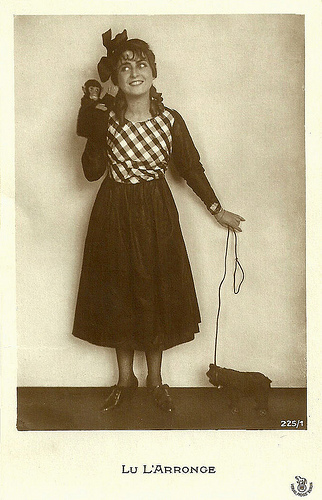
German postcard by Rotophot in the Film-Sterne series, no. 225/1, 1919-1924.
Half a woman, half a girl
Five years ago, when I wrote the first version of this post, there were some star postcards to prove that Lu L'Arronge must have been a well known actress at the time, but that surprisingly little was known about her. This has changed since then. Thanks to the sources mentioned below, we can now tell a bit more about Lu's life and work. But a lot still stays unclear.
Lu L'Arronge was born in 1902 and came from an old theatre family. Arronge is a variant for the Jewish names Aaron, Arons and Aronsohn. Her father was a cousin of stage writer Adolf L'Arronge. Her grandfather belonged to the founders of the Bühnengenossenschaft (the union organization of the German stage members) in 1871.
At an early age, Lu cherished the wish to become a stage actress, but her mother didn't accept that her daughter would become an actress. When the German film industry became 'modern' during World War I and conquered a huge public, Lu's wish to become an actress returned and she knew to convince her mother.
Thomas Schaedeli writes at his site Cyranos that Lu conquered the big screen from 1917 on. She played in films like Die Schlange der Kleopatra (1917), Lu's Backfischzeit (1917), Lu'chens Verlobung am Gartentor (1917), s'Liserl vom Loischtal (1917) and Kain (1918).
Schaedeli adds that she finally founded her own company in 1919, to star in films including Wenn's Landlüferl weht (1918), Anna Karenina (1919), Die weisse Maus/The White Mouse (1919), and Die Geisterbraut/The Ghost Bride (1919).
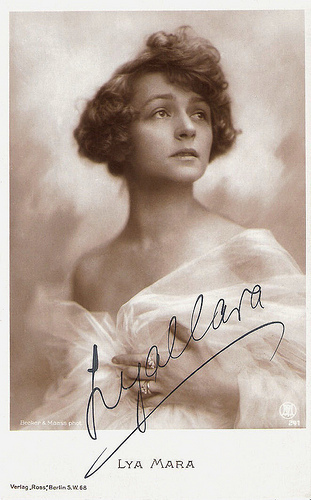
Lya Mara . German postcard by Ross Verlag, no. 241, 1919-1924. Photo: Becker & Maass.
The Ghost Bride
IMDb shows that Lu's production company L'Arronge Film GmbH was already founded in 1917 for the comedy Lu's Backfischzeit/Lu's Backfisch times (Franz Schmelter, 1917). L'Arronge Film GmbH produced 9 films including Wenn's Landlüferl weht (Karl Moos, 1918), and Die weisse Maus/The White Mouse (Leonhard Haskel, 1919), but then the film company halted.
In the Leo Tolstoy adaptation Anna Karenina (Friedrich Zelnik/Frederic Zelnik, 1919), Lu only had a minor part. Star of the film was Lya Mara and the film was produced by her and her husband-director's company Zelnik-Mara-Film.
L'Arronge's screen career quickly went downhill. IMDb lists only one more film appearance after her minor part in Anna Karenina (1919). Her final film was Die Geisterbraut/The Ghost Bride (Herbert Gerdes, 1920), produced by Georg Alexander 's company Neue Berliner Film. It must have been her final film.
A few years before, Lu was interviewed for the publication Die Frau im Film 1919 (The Woman in Film 1919), in which several female stars of the silent German cinema (including Erna Morena , Pola Negri , Lya Mara ) answered questions about their work. Lu said that she had "the big luck to be engaged at a new-created firm, for one year, which I gave my name. Here I prefer to play the high-spirited teenager things, half a woman, half a girl."
IMDd notes that Lu L'Arronge acted during her career in 14 films and that she produced 9 films. When she stopped she must have been only 18 or 19 years old. What happened with Lu after her film dream was over? I only know that she died in 1991 at the age of 89, but that's more than I could tell you five years ago.
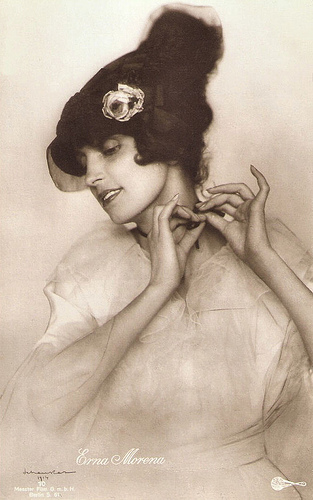
Erna Morena . German postcard by Messter Film GmbH, no. 10. Photo: Karl Schenker, 1914.
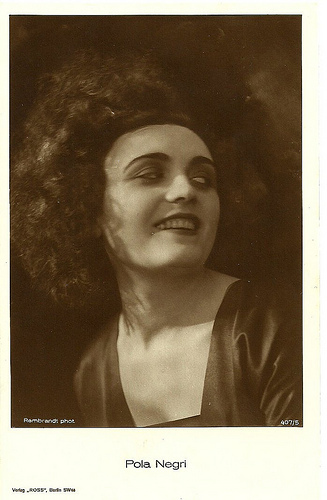
Pola Negri . German postcard by Ross Verlag, no. 407/5, 1919-1924. Photo: Rembrandt.
Sources: Thomas Staedeli (Cyranos), Die Frau im Film 1919, Filmportal.de, and .

German postcard by Zander & Labisch, Berlin.

German postcard by Rotophot in the Film-Sterne series, no. 225/1, 1919-1924.
Half a woman, half a girl
Five years ago, when I wrote the first version of this post, there were some star postcards to prove that Lu L'Arronge must have been a well known actress at the time, but that surprisingly little was known about her. This has changed since then. Thanks to the sources mentioned below, we can now tell a bit more about Lu's life and work. But a lot still stays unclear.
Lu L'Arronge was born in 1902 and came from an old theatre family. Arronge is a variant for the Jewish names Aaron, Arons and Aronsohn. Her father was a cousin of stage writer Adolf L'Arronge. Her grandfather belonged to the founders of the Bühnengenossenschaft (the union organization of the German stage members) in 1871.
At an early age, Lu cherished the wish to become a stage actress, but her mother didn't accept that her daughter would become an actress. When the German film industry became 'modern' during World War I and conquered a huge public, Lu's wish to become an actress returned and she knew to convince her mother.
Thomas Schaedeli writes at his site Cyranos that Lu conquered the big screen from 1917 on. She played in films like Die Schlange der Kleopatra (1917), Lu's Backfischzeit (1917), Lu'chens Verlobung am Gartentor (1917), s'Liserl vom Loischtal (1917) and Kain (1918).
Schaedeli adds that she finally founded her own company in 1919, to star in films including Wenn's Landlüferl weht (1918), Anna Karenina (1919), Die weisse Maus/The White Mouse (1919), and Die Geisterbraut/The Ghost Bride (1919).

Lya Mara . German postcard by Ross Verlag, no. 241, 1919-1924. Photo: Becker & Maass.
The Ghost Bride
IMDb shows that Lu's production company L'Arronge Film GmbH was already founded in 1917 for the comedy Lu's Backfischzeit/Lu's Backfisch times (Franz Schmelter, 1917). L'Arronge Film GmbH produced 9 films including Wenn's Landlüferl weht (Karl Moos, 1918), and Die weisse Maus/The White Mouse (Leonhard Haskel, 1919), but then the film company halted.
In the Leo Tolstoy adaptation Anna Karenina (Friedrich Zelnik/Frederic Zelnik, 1919), Lu only had a minor part. Star of the film was Lya Mara and the film was produced by her and her husband-director's company Zelnik-Mara-Film.
L'Arronge's screen career quickly went downhill. IMDb lists only one more film appearance after her minor part in Anna Karenina (1919). Her final film was Die Geisterbraut/The Ghost Bride (Herbert Gerdes, 1920), produced by Georg Alexander 's company Neue Berliner Film. It must have been her final film.
A few years before, Lu was interviewed for the publication Die Frau im Film 1919 (The Woman in Film 1919), in which several female stars of the silent German cinema (including Erna Morena , Pola Negri , Lya Mara ) answered questions about their work. Lu said that she had "the big luck to be engaged at a new-created firm, for one year, which I gave my name. Here I prefer to play the high-spirited teenager things, half a woman, half a girl."
IMDd notes that Lu L'Arronge acted during her career in 14 films and that she produced 9 films. When she stopped she must have been only 18 or 19 years old. What happened with Lu after her film dream was over? I only know that she died in 1991 at the age of 89, but that's more than I could tell you five years ago.

Erna Morena . German postcard by Messter Film GmbH, no. 10. Photo: Karl Schenker, 1914.

Pola Negri . German postcard by Ross Verlag, no. 407/5, 1919-1924. Photo: Rembrandt.
Sources: Thomas Staedeli (Cyranos), Die Frau im Film 1919, Filmportal.de, and .
Published on October 21, 2015 22:00
October 20, 2015
La Brière (1924)
La Brière (Léon Poirier, 1924) was a French rural film drama, based on a 1923 novel by Alphonse de Chateaubriant which had won the Prix Goncourt. The very atmospheric film, produced by the Compagnie Universelle Cinématographique, was shot in March-April 1924, partly at the Gaumont studios in Paris, partly on location at the fenscape at St. Joachim, Brière, a region west of Nantes, in French Brittany.
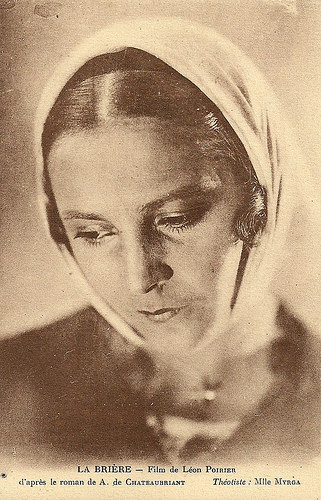
French postcard. Caption: Laurence Myrga as Théotiste.

French postcard. Caption: Moonlight over the Breton marsh.
Rough and unpolished
The story of the silent film La Brière/Passion and Peat (Léon Poirier, 1924) deals with the rough and unpolished men and women who inhabit the region of La Brière and live on peat cutting, when peat is running out.
A fierce argument breaks out about the draining of the marshes in service of the manufacture of bricks. An old stubborn man, Aoustin (José Davert), leads the resistance to the drainage project, and refuses to give his daughter Théotiste (Laurence Myrga) to a young peasant, Jeanin (Armand Tallier), who is in favour of the draining.
When a pregnant Théotiste is still refused marriage and Aoustin even wants to have Jeanin arrested for poaching, the latter shoots Aoustin's hand off. Théotiste has a miscarriage, is accused of killing her child, after which Jeanin and the whole community shun her.
Aoustin gets a wooden hand. He wants to kill Jeanin, but first needs to bring Théotiste to a hospital through the marshes. He gets lost in the freezing cold while his daughter dies. In the end Aoustin lets Jeanin go.

French postcard. Caption: The home of Aoustin (José Davert). In the back his wife (Jeanne Marie-Laurent) and daughter Théotiste (Laurence Myrga).

French postcard. Caption: Betrothal. Jeannin (Armand Tallier) and Théotiste (Laurence Myrga).
All because a daughter won’t obey her father
La Brière premiered on 23 April 1925 and despite its independent production, it was commercially launched by an exclusive month-long run at the Paris Madeleine-Cinéma. It was very successful.
The atmospheric cinematography of La Brière was done by Lucien Bellavoine, and the sets were designed by Robert-Jules Garnier. Paul Ladmirault from Nantes composed a special score for the silent film.
La Brière was the breakthrough of José Davert, an hitherto quite unknown actor, who would act in several films of Poirier afterwards, such as Verdun, vision d'histoire (1928). In addition to Davert, Laurence Myrga and Armand Tallier, Jeanne Marie-Laurent plays Aoustine, the mother.
Richard Abel writes in his study French Cinema. The First Wave, 1915-1929: “By 1924, the realist provincial film reached a kind of apotheosis in two large-scale productions which combined the French love for the ambiance of river or canal landscapes with their interest in the culture of Brittany.”
La Brière was one of the two. Abel: “For the most part, La Brière’s rhythm is slow, magisterial, in correspondence with the calm, flat landscape of the salt marsh and the lives of its rustic inhabitants. With his large solid physique and expressionless weathered face, Aoustin becomes an icon of the people’s determined resistance to change.”
Abel: "The socioeconomic conflict is displaced almost completely into the family, where it is resolved tragically in a romantic, moralistic plot that turns the old man’s rebellious vision into a form of blindness. Théotiste bears a dead child illegitimately; Aoustin loses a hand that is replaced by a wooden one; the salt marsh turns into bricks – all because a daughter won’t obey her father.”

French postcard. The idyll between Jeannin (Armand Tallier) and Théotiste (Laurence Myrga).
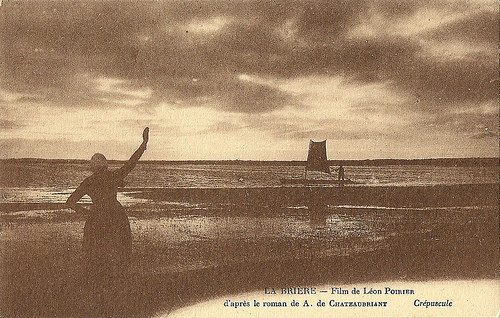
French postcard. Caption: Twilight.
Sources: Richard Abel (French Cinema. The First Wave, 1915-1929), Cinematheque Bretagne (French), Wikipedia, and IMDb.

French postcard. Caption: Laurence Myrga as Théotiste.

French postcard. Caption: Moonlight over the Breton marsh.
Rough and unpolished
The story of the silent film La Brière/Passion and Peat (Léon Poirier, 1924) deals with the rough and unpolished men and women who inhabit the region of La Brière and live on peat cutting, when peat is running out.
A fierce argument breaks out about the draining of the marshes in service of the manufacture of bricks. An old stubborn man, Aoustin (José Davert), leads the resistance to the drainage project, and refuses to give his daughter Théotiste (Laurence Myrga) to a young peasant, Jeanin (Armand Tallier), who is in favour of the draining.
When a pregnant Théotiste is still refused marriage and Aoustin even wants to have Jeanin arrested for poaching, the latter shoots Aoustin's hand off. Théotiste has a miscarriage, is accused of killing her child, after which Jeanin and the whole community shun her.
Aoustin gets a wooden hand. He wants to kill Jeanin, but first needs to bring Théotiste to a hospital through the marshes. He gets lost in the freezing cold while his daughter dies. In the end Aoustin lets Jeanin go.

French postcard. Caption: The home of Aoustin (José Davert). In the back his wife (Jeanne Marie-Laurent) and daughter Théotiste (Laurence Myrga).

French postcard. Caption: Betrothal. Jeannin (Armand Tallier) and Théotiste (Laurence Myrga).
All because a daughter won’t obey her father
La Brière premiered on 23 April 1925 and despite its independent production, it was commercially launched by an exclusive month-long run at the Paris Madeleine-Cinéma. It was very successful.
The atmospheric cinematography of La Brière was done by Lucien Bellavoine, and the sets were designed by Robert-Jules Garnier. Paul Ladmirault from Nantes composed a special score for the silent film.
La Brière was the breakthrough of José Davert, an hitherto quite unknown actor, who would act in several films of Poirier afterwards, such as Verdun, vision d'histoire (1928). In addition to Davert, Laurence Myrga and Armand Tallier, Jeanne Marie-Laurent plays Aoustine, the mother.
Richard Abel writes in his study French Cinema. The First Wave, 1915-1929: “By 1924, the realist provincial film reached a kind of apotheosis in two large-scale productions which combined the French love for the ambiance of river or canal landscapes with their interest in the culture of Brittany.”
La Brière was one of the two. Abel: “For the most part, La Brière’s rhythm is slow, magisterial, in correspondence with the calm, flat landscape of the salt marsh and the lives of its rustic inhabitants. With his large solid physique and expressionless weathered face, Aoustin becomes an icon of the people’s determined resistance to change.”
Abel: "The socioeconomic conflict is displaced almost completely into the family, where it is resolved tragically in a romantic, moralistic plot that turns the old man’s rebellious vision into a form of blindness. Théotiste bears a dead child illegitimately; Aoustin loses a hand that is replaced by a wooden one; the salt marsh turns into bricks – all because a daughter won’t obey her father.”

French postcard. The idyll between Jeannin (Armand Tallier) and Théotiste (Laurence Myrga).

French postcard. Caption: Twilight.
Sources: Richard Abel (French Cinema. The First Wave, 1915-1929), Cinematheque Bretagne (French), Wikipedia, and IMDb.
Published on October 20, 2015 22:00
October 19, 2015
Danièle Delorme (1926-2015)
On 17 October 2015, French actress and film producer Danièle Delorme passed away. Delorme acted in more than seventy films and television productions since 1942. She is probably best remembered for her starring roles in the original French production of Gigi (1948) and in Minne (1950), both based on novels by Colette. In the 1970s she played the female lead in the hit comedy Un éléphant ça trompe énormément/An Elephant Can Be Extremely Deceptive (1976). She also co-produced several films directed by her husband, Yves Robert, and other directors. Danièle Delorme was 89.

French postcard by SO ME FAB, Marseilles / Imp. De Marchi. Photo: Sam Lévin.
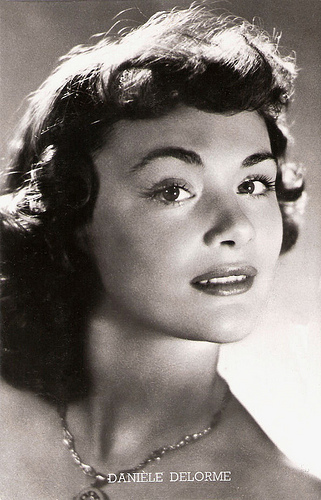
French postcard, no. 153.
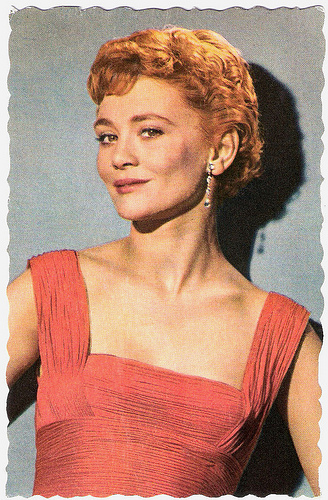
French postcard by Imp. De Marchi Frères, Marseille.
Colette
Danièle Delorme was born Gabrielle Danièle Marguerite Andrée Girard in 1926 in Levallois-Perret, France. Her parents were the painter and poster designer André Girard and his wife. Danièle aspired a musical career and studied to be a concert pianist, but the war and the French occupation by the Nazis interfered. She fled to Cannes, where she got acting classes from Jean Wall.
In 1942, she made her first stage appearances with the company of Claude Dauphin . She also made her film debut opposite Dauphin in La belle aventure/Twilight (Marc Allégret, 1942) using her birth name, Danièle Girard. The film was banned in 1943 by the German Occupation authorities because Dauphin had by then joined the F.F.L. (French Liberation Forces).
For her next film, Les petites du quai aux fleurs/The Girls of the Quai aux Fleurs (Marc Allégret, 1944) Girard adopted the stage name Delorme. After the liberation she finished her studies in Paris with lessons by René Simon and Tania Balachova. She played opposite Michel Auclair in Alain Resnais early film, Ouvert pour cause d'inventaire/Open for Inventory Causes (Alain Resnais, 1946). Sadly no copies of this film exist anymore.
The following year she played a small part in Les jeux sont faits/Second Chance (Jean Delannoy, 1947) starring Micheline Presle and based on an original scenario by the Jean-Paul Sartre. She also appeared in a supporting part in Maurice Tourneur’s last film, Impasse des Deux Anges/Dilemma of Two Angels (Maurice Tourneur, 1948) starring Paul Meurisse and Simone Signoret .
Then Delorme had her breakthrough in the title role of the original French production of Gigi (Jacqueline Audry, 1949), a decade before Leslie Caron starred in the famous 1958 Hollywood adaptation of the Colette’s classic novel directed by Vincente Minelli.
Reviewer Bensonj at IMDb writes: “This delightful film succeeds because of the talents of all who contributed to it, but mostly because of the fresh, light performance of Daniele Delorme in a role that could have been so much less. The young girl's mother and aunt expend extraordinary efforts to develop her into a high class mistress (without letting her in on the plan). This sordid idea is handled with a sure, light touch, succeeding because of the direction, writing and performances, especially that of Delorme, who is sweet but not too sweet, innocent but not too innocent, and above all bright, fresh and unaffected.”
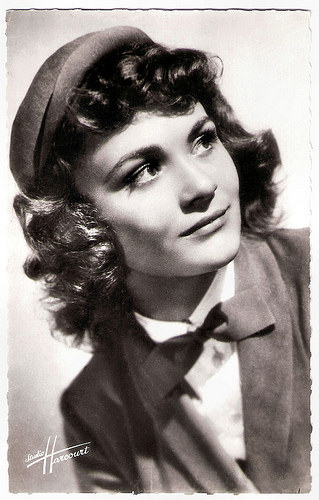
French postcard by Editions du Globe, Paris, no. 108. Photo: Studio Harcourt.
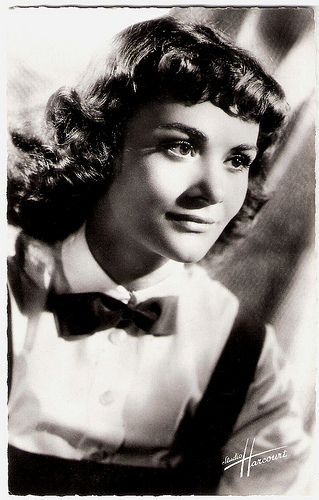
French postcard by Editions du Globe, Paris, no. 211. Photo: Studio Harcourt.
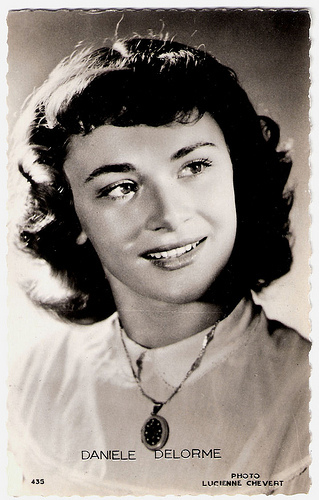
French postcard by Editions P.I., Paris, no. 435. Offert par les Carbones Korès. Photo: Lucienne Chevert.
Kept Girl
Danièle Delorme starred opposite Louis Jouvet and Bourvil in the title role of famous French suspense director Henri-George Clouzot’s only comedy Miquette et sa mère/Miquette (Henri-Georges Clouzot, 1950). The result was disappointing. JbduMonteil at IMDb writes: “There's nothing from his magic touch here. Reigning supreme over French suspense movies (Le corbeau, Les diaboliques, Le salaire de la peur), his art becomes ineffective when it comes to bittersweet albeit bland comedies like this one. The good cast (Louis ‘Quai des orfèvres’ Jouvet, Bourvil and Danielle Delorme does not make up for this trite story of an ingénue and these light-hearted gallantries. Probably the only Clouzot movie which is not worth watching”.
More successful was Minne, l'ingénue libertine/Minne (1950), again based on a Colette novel and directed by Jacqueline Audry, the first female director of the French sound cinema. Franck Vilard was again Delorme’s leading man. Among her next films is the experiment Traité de bave et d'éternité/Venom and Eternity (1951) in which Isidore Isou, the leader of the lettrist movement, lashes out at conventional cinema and offers a revolutionary form of film-making: through scratching and bleaching the film, through desynchronizing the soundtrack and the visual track, through deconstructing the story, he aims to renew the cinema the same way he tried to revolutionize the literary world.
Délorme’s cooperation with Jacqueline Audrey and Colette continued with Olivia/The Pit of Loneliness (Jacqueline Audry, 1953), which captures captures the awakening passions of an English adolescent (Marie-Claire Olivia) for her headmistress ( Edwige Feuillère ) at a small finishing school outside Paris. Délorme played an older student.
She was also one of the many stars who appeared in Si Versailles m’était conté/Affairs in Versailles (Sacha Guitry, 1954), a history of the Versailles palace from its founding by Louis XIII to the present. In Italy she played the wife of Marcello Mastroianni in an episode of the anthology film Tempi nostri/A Slice of Life (Alessandro Blasetti, Paul Paviot, 1954) and in the biopic Casa Ricordi/House of Ricordi (Carmine Gallone, 1954) about Giovanni Ricordi, who in 1807 made a deal with the Teatro La Scala in Milan to print all their music sheets, in exchange for the handwritten works of all the composers hired by the Scala.
Other films in which she starred were the drama Le dossier noir/Black Dossier (André Cayatte, 1955), the thriller Voici le temps des assassins.../Deadlier Than the Male (Julien Duvivier, 1956) as a femme fatale opposite Jean Gabin , and as Fantine in Les misérables (Jean-Paul Le Chanois, 1958).
In between there was another cooperation with Jacqueline Audry and Colette: Mistou ou Comment l'esprit vient aux filles... (Jacqueline Audry, 1956) in which she starred as a kept girl who lives in a desirable apartment which looks out onto the Eiffel Tower during the First World War. Besides her cinema appaerances, she also often worked in the theatre in plays by Jean Anouilh, Marcel Achard and Eugène Ionesco.
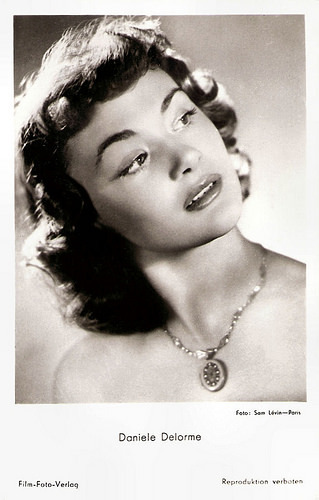
German postcard by Ufa Film-Foto-Verlag, Berlin-Tempelhof, no. FK 505. Photo: Sam Lévin, Paris.
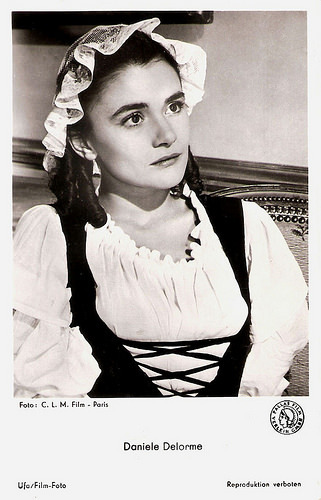
German postcard by Ufa, Berlin-Tempelhof, no. FK 954. Photo: C.L.M. Film, Paris / Pallas Film Verleih. Publicity still for Si Versailles m'était conté.../Fabulous Versailles (Sacha Guitry, 1954).
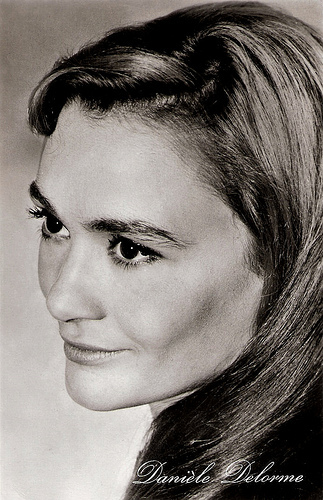
East-German postcard by VEB Progress Filmvertrieb, Berlin, no. 147/673, 1958. Photo: Defa. Publicity still for Les misérables (Jean-Paul Le Chanois, 1958).
Beware of Dark Sunglasses
In the early 1960s, Daniële Delorme worked a few times with some of the young directors of the Nouvelle Vague. She appeared with Anna Karina and Jean-Luc Godard in Agnès Varda’s short comedy Les fiancés du pont Mac Donald ou (Méfiez-vous des lunettes noires)/The Lovers of the Pont mac Donald (Beware of Dark Sunglasses) (Agnès Varda, 1961) and appeared again for Varda’s camera in the classic Cléo de 5 à 7/Cleo From 5 To 7 (Agnès Varda, 1962) featuring Corinne Marchand.
She also played in other interesting films such as the crime film Le septième juré/The Seventh Juror (Georges Lautner, 1964) with Bernard Blier , Le voyou/The Crook (Claude Lelouch, 1970) featuring Jean-Louis Trintignant , and Belle (André Delvaux, 1974) opposite Jean-Luc Bideau.
Although she continued to play leading parts, her appearances in the cinema had become rarer but her film career got a boost with the hit comedy Un éléphant ça trompe énormément/An Elephant Can Be Extremely Deceptive (Yves Robert, 1976) in which she played the wife of Jean Rochefort .
IMDb reviewer David Vanholsbeeck comments: “Whereas the story may not be very original, this film is extremely charming and amiable nonetheless. It has a great supporting cast ((Claude) Brasseur is a stand-out), very funny moments and many real-life characters. Too bad this charming little film was later remade as The Woman in Red (with Gene Wilder and Kelly LeBrock). But Hollywood seems to have this ‘urge’ to make their own version of each film with a bit of success outside the States. Anyway, if you have to choose between the original and the remake, choose Un éléphant...(or Pardon mon affaire as it is sometimes called).”
A year later the sequel Nous irons tous au paradis/Pardon Mon Affaire, Too! (Yves Robert, 1977) with the same cast was also a hit. At IMDb, Bob Taylor reviews: “Daniele Delorme, who was married to Yves Robert, is the real treasure in this picture. Her career as actress spanned three decades of steady work before she started a production company with her husband. Here she is a wonderful foil for Rochefort in their tense domestic scenes together; she's calm while he's agitated.”
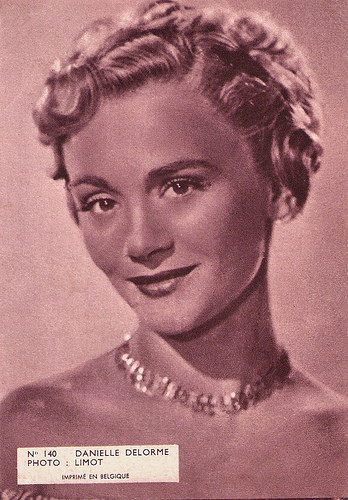
Belgian collectors card by Cinema Novy, Nevele, no. 140. Photo: Limot.
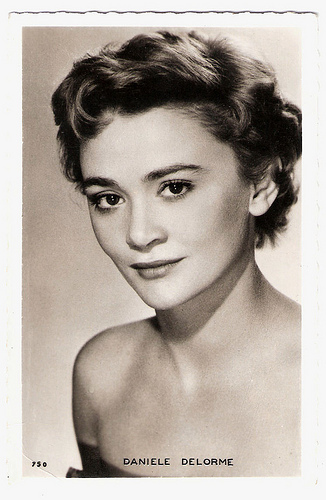
French postcard by Editions P.I., Paris, no. 750. Photo: Sam Lévin.
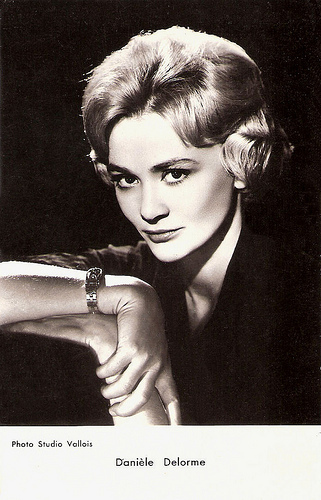
French postcard by Editions P.I., Paris, no. 971. Photo: Studio Vallois.
Phenomenal Success
Danièle Delorme was since 1956 married to the director of the two comedies above, Yves Robert and they were partners in film production company La Guéville. In 1962 she had co-produced with him La guerre des boutons/The War of the Buttons (Yves Robert, 1962), based on a classic French anti-war novel of the same title written in 1912 by Louis Pergaud.
James Travers reviews at Films de France : “La Guerre des boutons is one of the most important films about childhood in French cinema, certainly one of the most memorable. It was made at the height of France’s protracted and costly war with Algeria, something which may have contributed to director Yves Robert’s problems in finding a financial backer for the film. In the end, he had to set up his own production company with his wife, Danièle Delorme. No French distribution company would touch the film, so Robert was forced to turn to the Americans - Warner Brothers took up the challenge, but without any great enthusiasm. No one, least of all its director, could have anticipated the film’s phenomenal success. It attracted just under 10 million spectators in France and was also an international hit. The film was well-received by the critics, and won the prestigious Prix Jean Vigo in 1962.”
Other films that she coproduced with her husband were Les Copains/The Buddies (Yves Robert, 1965) with Philippe Noiret, and the comedy Alexandre le bienheureux/Very Happy Alexander (Yves Robert, 1968) again starring Noiret. Later she also worked with other directors such as Jacques Doillon on La drôlesse/The Hussy (1979), and with Alain Cavalier on Un étrange voyage/A Strange Trip (1981). In this period she also appeared in TV projects as La naissance du jour/Daybreak (1980), directed by Jacques Demy and based on a novel by Colette. She served as a member of the jury at the 1988 Cannes Film Festival.
Her last film appearance was in the short film La vie sans secret de Walter Nions/The Secretless Life of Walter Nions (Hugo Gélin, 2001) which featured her former film husband Jean Rochefort . In real life Danièle Delorme had married actor Daniel Gélin in 1945. A year later they had a son, Xavier Gélin. Delorme divorced Gélin in 1954 after he admitted having an affair with Romanian-born model Marie Christine Schneider, that produced a daughter, Maria Schneider. Xavier Gélin (1946–1999) was a successful actor who died of cancer at the age of fifty-three.
Delorme and Yves Robert remained married until his death in 2002. More recently Delorme worked as an associate producer on the mystery drama UV (Gilles Paquet-Brenner, 2007) with Jacques Dutronc and Marthe Keller .
Danièle Delorme died in Paris on 17 October 2015. She was 89.
Miquette et sa mère/Miquette (Henri-Georges Clouzot, 1950). Source: luc lebelge22 (YouTube).
Gigi (Jacqueline Audry, 1949). Source: luc lebelge22 (YouTube).
French trailer for Nous irons tous au paradis (Yves Robert, 1977). Source: Raoul Gauguin (YouTube).
Sources: James Travers (Films de France), Bensonj (IMDb), David Vanholsbeeck (IMDb), Bob Taylor (IMDb), AlloCiné (French), Wikipedia (English and French), and .

French postcard by SO ME FAB, Marseilles / Imp. De Marchi. Photo: Sam Lévin.

French postcard, no. 153.

French postcard by Imp. De Marchi Frères, Marseille.
Colette
Danièle Delorme was born Gabrielle Danièle Marguerite Andrée Girard in 1926 in Levallois-Perret, France. Her parents were the painter and poster designer André Girard and his wife. Danièle aspired a musical career and studied to be a concert pianist, but the war and the French occupation by the Nazis interfered. She fled to Cannes, where she got acting classes from Jean Wall.
In 1942, she made her first stage appearances with the company of Claude Dauphin . She also made her film debut opposite Dauphin in La belle aventure/Twilight (Marc Allégret, 1942) using her birth name, Danièle Girard. The film was banned in 1943 by the German Occupation authorities because Dauphin had by then joined the F.F.L. (French Liberation Forces).
For her next film, Les petites du quai aux fleurs/The Girls of the Quai aux Fleurs (Marc Allégret, 1944) Girard adopted the stage name Delorme. After the liberation she finished her studies in Paris with lessons by René Simon and Tania Balachova. She played opposite Michel Auclair in Alain Resnais early film, Ouvert pour cause d'inventaire/Open for Inventory Causes (Alain Resnais, 1946). Sadly no copies of this film exist anymore.
The following year she played a small part in Les jeux sont faits/Second Chance (Jean Delannoy, 1947) starring Micheline Presle and based on an original scenario by the Jean-Paul Sartre. She also appeared in a supporting part in Maurice Tourneur’s last film, Impasse des Deux Anges/Dilemma of Two Angels (Maurice Tourneur, 1948) starring Paul Meurisse and Simone Signoret .
Then Delorme had her breakthrough in the title role of the original French production of Gigi (Jacqueline Audry, 1949), a decade before Leslie Caron starred in the famous 1958 Hollywood adaptation of the Colette’s classic novel directed by Vincente Minelli.
Reviewer Bensonj at IMDb writes: “This delightful film succeeds because of the talents of all who contributed to it, but mostly because of the fresh, light performance of Daniele Delorme in a role that could have been so much less. The young girl's mother and aunt expend extraordinary efforts to develop her into a high class mistress (without letting her in on the plan). This sordid idea is handled with a sure, light touch, succeeding because of the direction, writing and performances, especially that of Delorme, who is sweet but not too sweet, innocent but not too innocent, and above all bright, fresh and unaffected.”

French postcard by Editions du Globe, Paris, no. 108. Photo: Studio Harcourt.

French postcard by Editions du Globe, Paris, no. 211. Photo: Studio Harcourt.

French postcard by Editions P.I., Paris, no. 435. Offert par les Carbones Korès. Photo: Lucienne Chevert.
Kept Girl
Danièle Delorme starred opposite Louis Jouvet and Bourvil in the title role of famous French suspense director Henri-George Clouzot’s only comedy Miquette et sa mère/Miquette (Henri-Georges Clouzot, 1950). The result was disappointing. JbduMonteil at IMDb writes: “There's nothing from his magic touch here. Reigning supreme over French suspense movies (Le corbeau, Les diaboliques, Le salaire de la peur), his art becomes ineffective when it comes to bittersweet albeit bland comedies like this one. The good cast (Louis ‘Quai des orfèvres’ Jouvet, Bourvil and Danielle Delorme does not make up for this trite story of an ingénue and these light-hearted gallantries. Probably the only Clouzot movie which is not worth watching”.
More successful was Minne, l'ingénue libertine/Minne (1950), again based on a Colette novel and directed by Jacqueline Audry, the first female director of the French sound cinema. Franck Vilard was again Delorme’s leading man. Among her next films is the experiment Traité de bave et d'éternité/Venom and Eternity (1951) in which Isidore Isou, the leader of the lettrist movement, lashes out at conventional cinema and offers a revolutionary form of film-making: through scratching and bleaching the film, through desynchronizing the soundtrack and the visual track, through deconstructing the story, he aims to renew the cinema the same way he tried to revolutionize the literary world.
Délorme’s cooperation with Jacqueline Audrey and Colette continued with Olivia/The Pit of Loneliness (Jacqueline Audry, 1953), which captures captures the awakening passions of an English adolescent (Marie-Claire Olivia) for her headmistress ( Edwige Feuillère ) at a small finishing school outside Paris. Délorme played an older student.
She was also one of the many stars who appeared in Si Versailles m’était conté/Affairs in Versailles (Sacha Guitry, 1954), a history of the Versailles palace from its founding by Louis XIII to the present. In Italy she played the wife of Marcello Mastroianni in an episode of the anthology film Tempi nostri/A Slice of Life (Alessandro Blasetti, Paul Paviot, 1954) and in the biopic Casa Ricordi/House of Ricordi (Carmine Gallone, 1954) about Giovanni Ricordi, who in 1807 made a deal with the Teatro La Scala in Milan to print all their music sheets, in exchange for the handwritten works of all the composers hired by the Scala.
Other films in which she starred were the drama Le dossier noir/Black Dossier (André Cayatte, 1955), the thriller Voici le temps des assassins.../Deadlier Than the Male (Julien Duvivier, 1956) as a femme fatale opposite Jean Gabin , and as Fantine in Les misérables (Jean-Paul Le Chanois, 1958).
In between there was another cooperation with Jacqueline Audry and Colette: Mistou ou Comment l'esprit vient aux filles... (Jacqueline Audry, 1956) in which she starred as a kept girl who lives in a desirable apartment which looks out onto the Eiffel Tower during the First World War. Besides her cinema appaerances, she also often worked in the theatre in plays by Jean Anouilh, Marcel Achard and Eugène Ionesco.

German postcard by Ufa Film-Foto-Verlag, Berlin-Tempelhof, no. FK 505. Photo: Sam Lévin, Paris.

German postcard by Ufa, Berlin-Tempelhof, no. FK 954. Photo: C.L.M. Film, Paris / Pallas Film Verleih. Publicity still for Si Versailles m'était conté.../Fabulous Versailles (Sacha Guitry, 1954).

East-German postcard by VEB Progress Filmvertrieb, Berlin, no. 147/673, 1958. Photo: Defa. Publicity still for Les misérables (Jean-Paul Le Chanois, 1958).
Beware of Dark Sunglasses
In the early 1960s, Daniële Delorme worked a few times with some of the young directors of the Nouvelle Vague. She appeared with Anna Karina and Jean-Luc Godard in Agnès Varda’s short comedy Les fiancés du pont Mac Donald ou (Méfiez-vous des lunettes noires)/The Lovers of the Pont mac Donald (Beware of Dark Sunglasses) (Agnès Varda, 1961) and appeared again for Varda’s camera in the classic Cléo de 5 à 7/Cleo From 5 To 7 (Agnès Varda, 1962) featuring Corinne Marchand.
She also played in other interesting films such as the crime film Le septième juré/The Seventh Juror (Georges Lautner, 1964) with Bernard Blier , Le voyou/The Crook (Claude Lelouch, 1970) featuring Jean-Louis Trintignant , and Belle (André Delvaux, 1974) opposite Jean-Luc Bideau.
Although she continued to play leading parts, her appearances in the cinema had become rarer but her film career got a boost with the hit comedy Un éléphant ça trompe énormément/An Elephant Can Be Extremely Deceptive (Yves Robert, 1976) in which she played the wife of Jean Rochefort .
IMDb reviewer David Vanholsbeeck comments: “Whereas the story may not be very original, this film is extremely charming and amiable nonetheless. It has a great supporting cast ((Claude) Brasseur is a stand-out), very funny moments and many real-life characters. Too bad this charming little film was later remade as The Woman in Red (with Gene Wilder and Kelly LeBrock). But Hollywood seems to have this ‘urge’ to make their own version of each film with a bit of success outside the States. Anyway, if you have to choose between the original and the remake, choose Un éléphant...(or Pardon mon affaire as it is sometimes called).”
A year later the sequel Nous irons tous au paradis/Pardon Mon Affaire, Too! (Yves Robert, 1977) with the same cast was also a hit. At IMDb, Bob Taylor reviews: “Daniele Delorme, who was married to Yves Robert, is the real treasure in this picture. Her career as actress spanned three decades of steady work before she started a production company with her husband. Here she is a wonderful foil for Rochefort in their tense domestic scenes together; she's calm while he's agitated.”

Belgian collectors card by Cinema Novy, Nevele, no. 140. Photo: Limot.

French postcard by Editions P.I., Paris, no. 750. Photo: Sam Lévin.

French postcard by Editions P.I., Paris, no. 971. Photo: Studio Vallois.
Phenomenal Success
Danièle Delorme was since 1956 married to the director of the two comedies above, Yves Robert and they were partners in film production company La Guéville. In 1962 she had co-produced with him La guerre des boutons/The War of the Buttons (Yves Robert, 1962), based on a classic French anti-war novel of the same title written in 1912 by Louis Pergaud.
James Travers reviews at Films de France : “La Guerre des boutons is one of the most important films about childhood in French cinema, certainly one of the most memorable. It was made at the height of France’s protracted and costly war with Algeria, something which may have contributed to director Yves Robert’s problems in finding a financial backer for the film. In the end, he had to set up his own production company with his wife, Danièle Delorme. No French distribution company would touch the film, so Robert was forced to turn to the Americans - Warner Brothers took up the challenge, but without any great enthusiasm. No one, least of all its director, could have anticipated the film’s phenomenal success. It attracted just under 10 million spectators in France and was also an international hit. The film was well-received by the critics, and won the prestigious Prix Jean Vigo in 1962.”
Other films that she coproduced with her husband were Les Copains/The Buddies (Yves Robert, 1965) with Philippe Noiret, and the comedy Alexandre le bienheureux/Very Happy Alexander (Yves Robert, 1968) again starring Noiret. Later she also worked with other directors such as Jacques Doillon on La drôlesse/The Hussy (1979), and with Alain Cavalier on Un étrange voyage/A Strange Trip (1981). In this period she also appeared in TV projects as La naissance du jour/Daybreak (1980), directed by Jacques Demy and based on a novel by Colette. She served as a member of the jury at the 1988 Cannes Film Festival.
Her last film appearance was in the short film La vie sans secret de Walter Nions/The Secretless Life of Walter Nions (Hugo Gélin, 2001) which featured her former film husband Jean Rochefort . In real life Danièle Delorme had married actor Daniel Gélin in 1945. A year later they had a son, Xavier Gélin. Delorme divorced Gélin in 1954 after he admitted having an affair with Romanian-born model Marie Christine Schneider, that produced a daughter, Maria Schneider. Xavier Gélin (1946–1999) was a successful actor who died of cancer at the age of fifty-three.
Delorme and Yves Robert remained married until his death in 2002. More recently Delorme worked as an associate producer on the mystery drama UV (Gilles Paquet-Brenner, 2007) with Jacques Dutronc and Marthe Keller .
Danièle Delorme died in Paris on 17 October 2015. She was 89.
Miquette et sa mère/Miquette (Henri-Georges Clouzot, 1950). Source: luc lebelge22 (YouTube).
Gigi (Jacqueline Audry, 1949). Source: luc lebelge22 (YouTube).
French trailer for Nous irons tous au paradis (Yves Robert, 1977). Source: Raoul Gauguin (YouTube).
Sources: James Travers (Films de France), Bensonj (IMDb), David Vanholsbeeck (IMDb), Bob Taylor (IMDb), AlloCiné (French), Wikipedia (English and French), and .
Published on October 19, 2015 16:30
October 18, 2015
Willy Birgel
German actor Willy Birgel (1891-1973) started his film career when he was already over 40. He was the charming grand seigneur of the Ufa films of the 1930s. Despite his many appearances in Nazi propaganda films, he became again a very busy film actor in the German cinema of the 1950s.
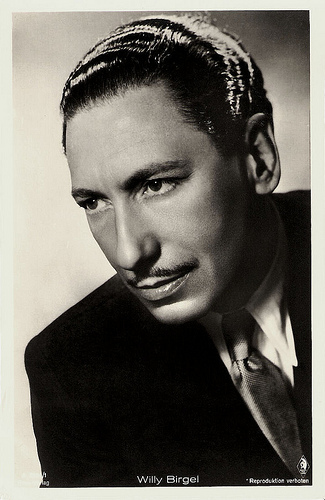
German postcard by Ross Verlag, no. A 2991/1, 1939-1940. Photo: Bavaria Filmkunst.
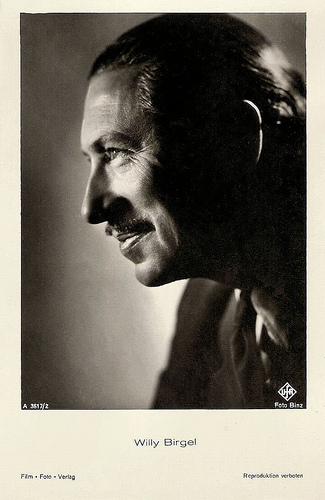
German postcard by Film-Foto-Verlag, no. A 3617. Photo: Ufa / Binz.
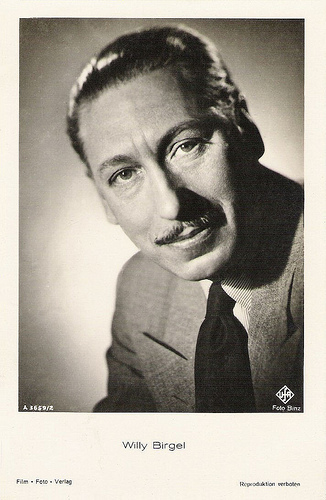
German postcard by Film-Foto-Verlag, no. A 3659/2. Photo: Ufa / Binz.
Staatsschauspieler
Wilhelm Maria (Willy) Birgel was born in 1891, in Köln (Cologne), Germany. He was the son of Johann Heinrich Birgel, a goldsmith and engraver, and his wife Henriette (born Dreyers).
Willy began his acting career in 1912 on the stage in Köln. In the following years he played in theatres in Bonn, Dessau, Köln and Koblenz. The first World War interrupted in 1915 his career and he was wounded while serving with a German artillery unit in Serbia. After the war he continued his stage career in the theatre of Aachen. In 1924 he became a company member of the Nationaltheater of Mannheim, where he had triumphs with roles like Faust and Mephistopheles in Goethe’s Faust I, Franz Moor in Schiller’s Die Räuber/The Robbers and the title characters in Shakespeare’s Hamlet and Richard III.
His film debut came rather late. He was already over forty years old before he got his first major film role as the English Camp Commandant in Ein Mann will nach Deutschland/A Man Wants to Get to Germany (Paul Wegener, 1934). This Ufa-production portrayed a German engineer ( Karl Ludwig Diehl ) living in South America who hears in 1914 of the war in Europe. He has only one thought: home to Germany to help a fatherland under attack. The film showed of the kind of German values that were emphasized in Nazi Germany.
Other films he made for the National Socialist Regime included Unternehmen Michael/The Private's Job (Karl Ritter, 1937), Feinde/Enemies (Viktor Tourjansky, 1940) with Brigitte Horney, and Kameraden/Comrades (Hans Schweikart, 1941). In 1937, Reichspropagandaminister Joseph Goebbels named Birgel Staatsschauspieler (Actor of the State), the highest honor for German actors at the time. Beside the propaganda films, he starred in several popular entertainment films becoming an unlikely public favorite.
Birgel had his first leading part in Fürst Woronzeff/Prince Woronzeff (Artur Robison, 1934). He appeared as a chivalrous aristocrat and distinguished gentleman in Das Mädchen Johanna/Joan of Arc (Gustav Ucicky, 1935) with Gustaf Gründgens and Heinrich George , in Schlussakkord/Final Accord (Detlev Sierck/Douglas Sirk, 1936) with Lil Dagover , and in Fanny Elssler (Paul Martin, 1937) with Lilian Harvey . Great successes were Zu neuen Ufern/To New Shores (Detlev Sierck/Douglas Sirk, 1937) and Der Blaufuchs/The Blue Fox (Viktor Tourjansky, 1938), both in which he appeared at Zarah Leander 's side.
Meanwhile he also had success on stage at the Berliner Volksbühne. Till the end of the war he continued his career with films like Der Fall Deruga/The Deruga Case (Fritz Peter Buch, 1938), Maria Ilona (Géza von Bolváry, 1939) opposite Paula Wessely , Das Herz der Königin/The Heart of a Queen (Carl Froelich, 1940) with Zarah Leander , ...reitet für Deutschland/Riding for Germany (Arthur Maria Rabenalt, 1941), the Rudolf Diesel biography Diesel (Gerhard Lamprecht, 1942), and Der Majoratsherr (Hans Deppe, 1944).
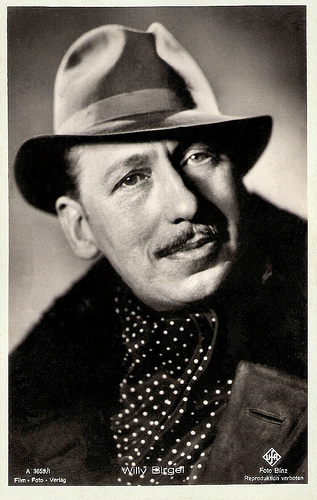
German postcard by Film-Foto-Verlag, no. A 3659/1, 1941-1944. Photo: Ufa / Binz.
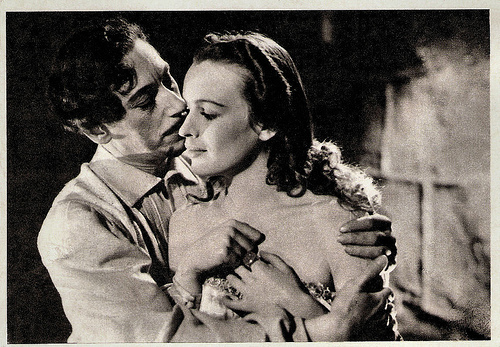
German postcard by Das Illustrierte Blatt. Photo: Ufa / Lindner. Publicity still for Das Herz der Königin/Mary Queen of Scots (Carl Froelich, 1940) with Lotte Koch .
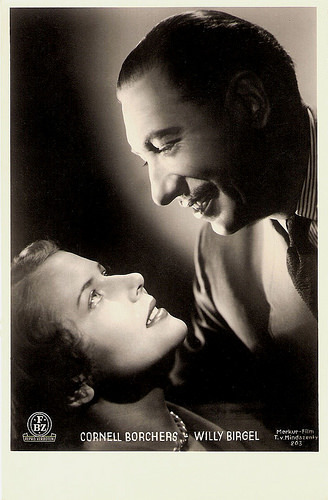
German postcard by FBZ, no. 225. Photo: Merkur-Film / T. v. Mindszenty. Publicity still for Das ewige Spiel/The eternal game (Frantisek Cáp, 1951) with Cornell Borchers .
On the Allied Black-list
After World War II, Willy Birgel was on the Allied black-list and did not make another film until 1947. Director Harald Braun and producer Erich Pommer offered him a role in Zwischen gestern und morgen/ Between Yesterday and Tomorrow (Harald Braun, 1947) with Hildegard Knef .
By the 1950s, he was back on the level of his pre-war popularity. He often appeared together with superstar Hans Albers , for example in Vom Teufel gejagt/Hunted by the Devil (Viktor Tourjansky, 1950). He specialized in supporting roles as the elderly grand seigneur and also of the father figure, and appeared in many Heimatfilms, for example Heidi (Luigi Comencini, 1952), and Johannisnacht/Midsummer Night (Harald Reinl, 1956) with Hertha Feiler .
In the 1960s, Birgel was able to make the transition to television. In the cinema he was seen in films like Frau Cheneys Ende/The End of Mrs. Cheney (Franz Josef Wild, 1961) with Lilli Palmer , and Sommersprossen/Beyond Control (Helmut Förnbacher, 1968). Interesting was Schonzeit für Füchse/No Shooting Time for Foxes (Peter Schamoni, 1966) in which Birgel made fun of his own image. The film won the Silver Bear of the Berlin Film Festival.
In 1966 Birgel himself won the Bundesfilmpreis, a honorary award for his continued outstanding individual contributions to the German film over the years. He was also awarded the Bambi award in 1960 and the Filmband im Gold award in 1964 and 1966. His last film was the Italian film Il Gesto/The Gesture (Marcello Grottesi, 1973).
Willy Birgel died in 1973 of heart failure, in Dübendorf, Zürich, Switzerland. He was buried in his birth city, Köln. Birgel was married twice: first to actress Carola Cajetan, with whom he had a son, and later to actress Charlotte Michael, with whom he had a daughter. Both his marriages ended in a divorce.
I loved this comment by Miss Mertens at one of our postcards at Flickr : "From my mother I know, that it was the biggest compliment in the 1940s, when somebody told a man: 'You are looking like Willy Birgel'."
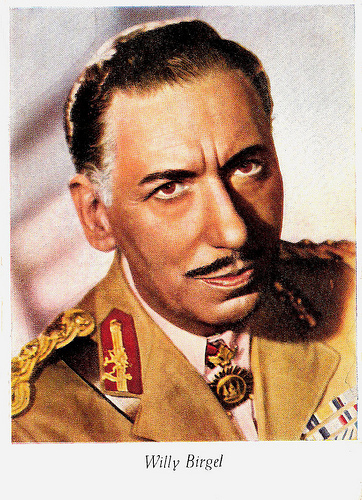
German postcard by Werbedrück Rudolf Stepanek, München. Photo: Gloria / Lilo. Publicity still for Sterne über Colombo/Stars Over Colombo (Veit Harlan, 1953) and Die Gefangene des Maharadscha/Circus Girl (Veit Harlan, 1954).
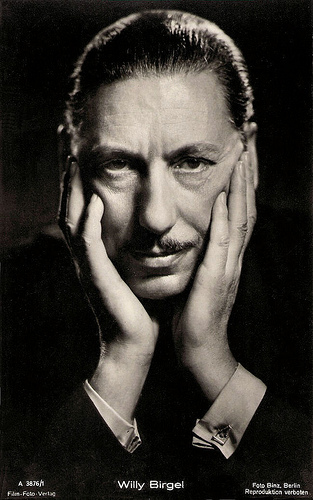
German postcard by Film-Foto-Verlag, no. A 3876/1. Photo: Ufa / Binz, Berlin.
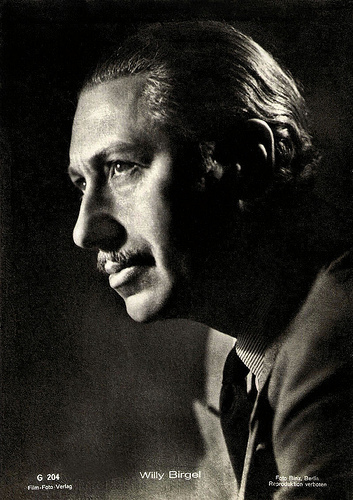
German postcard by Film-Foto-Verlag, no. G 204, 1941-1944. Photo: Binz.
Sources: Wikipedia, Deutsches Historisches Museum (German), Thomas Staedeli (Cyranos), Miss Mertens (Flickr) and .

German postcard by Ross Verlag, no. A 2991/1, 1939-1940. Photo: Bavaria Filmkunst.

German postcard by Film-Foto-Verlag, no. A 3617. Photo: Ufa / Binz.

German postcard by Film-Foto-Verlag, no. A 3659/2. Photo: Ufa / Binz.
Staatsschauspieler
Wilhelm Maria (Willy) Birgel was born in 1891, in Köln (Cologne), Germany. He was the son of Johann Heinrich Birgel, a goldsmith and engraver, and his wife Henriette (born Dreyers).
Willy began his acting career in 1912 on the stage in Köln. In the following years he played in theatres in Bonn, Dessau, Köln and Koblenz. The first World War interrupted in 1915 his career and he was wounded while serving with a German artillery unit in Serbia. After the war he continued his stage career in the theatre of Aachen. In 1924 he became a company member of the Nationaltheater of Mannheim, where he had triumphs with roles like Faust and Mephistopheles in Goethe’s Faust I, Franz Moor in Schiller’s Die Räuber/The Robbers and the title characters in Shakespeare’s Hamlet and Richard III.
His film debut came rather late. He was already over forty years old before he got his first major film role as the English Camp Commandant in Ein Mann will nach Deutschland/A Man Wants to Get to Germany (Paul Wegener, 1934). This Ufa-production portrayed a German engineer ( Karl Ludwig Diehl ) living in South America who hears in 1914 of the war in Europe. He has only one thought: home to Germany to help a fatherland under attack. The film showed of the kind of German values that were emphasized in Nazi Germany.
Other films he made for the National Socialist Regime included Unternehmen Michael/The Private's Job (Karl Ritter, 1937), Feinde/Enemies (Viktor Tourjansky, 1940) with Brigitte Horney, and Kameraden/Comrades (Hans Schweikart, 1941). In 1937, Reichspropagandaminister Joseph Goebbels named Birgel Staatsschauspieler (Actor of the State), the highest honor for German actors at the time. Beside the propaganda films, he starred in several popular entertainment films becoming an unlikely public favorite.
Birgel had his first leading part in Fürst Woronzeff/Prince Woronzeff (Artur Robison, 1934). He appeared as a chivalrous aristocrat and distinguished gentleman in Das Mädchen Johanna/Joan of Arc (Gustav Ucicky, 1935) with Gustaf Gründgens and Heinrich George , in Schlussakkord/Final Accord (Detlev Sierck/Douglas Sirk, 1936) with Lil Dagover , and in Fanny Elssler (Paul Martin, 1937) with Lilian Harvey . Great successes were Zu neuen Ufern/To New Shores (Detlev Sierck/Douglas Sirk, 1937) and Der Blaufuchs/The Blue Fox (Viktor Tourjansky, 1938), both in which he appeared at Zarah Leander 's side.
Meanwhile he also had success on stage at the Berliner Volksbühne. Till the end of the war he continued his career with films like Der Fall Deruga/The Deruga Case (Fritz Peter Buch, 1938), Maria Ilona (Géza von Bolváry, 1939) opposite Paula Wessely , Das Herz der Königin/The Heart of a Queen (Carl Froelich, 1940) with Zarah Leander , ...reitet für Deutschland/Riding for Germany (Arthur Maria Rabenalt, 1941), the Rudolf Diesel biography Diesel (Gerhard Lamprecht, 1942), and Der Majoratsherr (Hans Deppe, 1944).

German postcard by Film-Foto-Verlag, no. A 3659/1, 1941-1944. Photo: Ufa / Binz.

German postcard by Das Illustrierte Blatt. Photo: Ufa / Lindner. Publicity still for Das Herz der Königin/Mary Queen of Scots (Carl Froelich, 1940) with Lotte Koch .

German postcard by FBZ, no. 225. Photo: Merkur-Film / T. v. Mindszenty. Publicity still for Das ewige Spiel/The eternal game (Frantisek Cáp, 1951) with Cornell Borchers .
On the Allied Black-list
After World War II, Willy Birgel was on the Allied black-list and did not make another film until 1947. Director Harald Braun and producer Erich Pommer offered him a role in Zwischen gestern und morgen/ Between Yesterday and Tomorrow (Harald Braun, 1947) with Hildegard Knef .
By the 1950s, he was back on the level of his pre-war popularity. He often appeared together with superstar Hans Albers , for example in Vom Teufel gejagt/Hunted by the Devil (Viktor Tourjansky, 1950). He specialized in supporting roles as the elderly grand seigneur and also of the father figure, and appeared in many Heimatfilms, for example Heidi (Luigi Comencini, 1952), and Johannisnacht/Midsummer Night (Harald Reinl, 1956) with Hertha Feiler .
In the 1960s, Birgel was able to make the transition to television. In the cinema he was seen in films like Frau Cheneys Ende/The End of Mrs. Cheney (Franz Josef Wild, 1961) with Lilli Palmer , and Sommersprossen/Beyond Control (Helmut Förnbacher, 1968). Interesting was Schonzeit für Füchse/No Shooting Time for Foxes (Peter Schamoni, 1966) in which Birgel made fun of his own image. The film won the Silver Bear of the Berlin Film Festival.
In 1966 Birgel himself won the Bundesfilmpreis, a honorary award for his continued outstanding individual contributions to the German film over the years. He was also awarded the Bambi award in 1960 and the Filmband im Gold award in 1964 and 1966. His last film was the Italian film Il Gesto/The Gesture (Marcello Grottesi, 1973).
Willy Birgel died in 1973 of heart failure, in Dübendorf, Zürich, Switzerland. He was buried in his birth city, Köln. Birgel was married twice: first to actress Carola Cajetan, with whom he had a son, and later to actress Charlotte Michael, with whom he had a daughter. Both his marriages ended in a divorce.
I loved this comment by Miss Mertens at one of our postcards at Flickr : "From my mother I know, that it was the biggest compliment in the 1940s, when somebody told a man: 'You are looking like Willy Birgel'."

German postcard by Werbedrück Rudolf Stepanek, München. Photo: Gloria / Lilo. Publicity still for Sterne über Colombo/Stars Over Colombo (Veit Harlan, 1953) and Die Gefangene des Maharadscha/Circus Girl (Veit Harlan, 1954).

German postcard by Film-Foto-Verlag, no. A 3876/1. Photo: Ufa / Binz, Berlin.

German postcard by Film-Foto-Verlag, no. G 204, 1941-1944. Photo: Binz.
Sources: Wikipedia, Deutsches Historisches Museum (German), Thomas Staedeli (Cyranos), Miss Mertens (Flickr) and .
Published on October 18, 2015 22:00
October 17, 2015
Renée Björling
Renée Björling (1888-1975) was a Swedish film and stage actress, who peaked in the Swedish silent cinema, but also played small parts in Ingmar Bergman's films.

Swedish postcard by Nordisk Konst, Stockholm, no. 1116/2. Photo: publicity still for Carolina Rediviva (Ivan Hedqvist, 1920) with Richard Lund.

Swedish postcard by Nordisk Konst, Stockholm, no. 1091/?. Photo: publicity still for the Swedish silent film Dunungen/In Quest of Happiness (Ivan Hedqvist, 1919), based on a novel by Selma Lagerlöf. The man in the middle is director Ivan Hedqvist as Theodor and the lady on the left is Jenny Tschernichin-Larsson, who plays Teodor's mother.
The Quest for Happiness
Renée Louise Björling, born in 1888 in Lovö, was the daughter of actress Manda Björling (1876–1960). Her half-sister was opera singer Sigurd Björling (1907–1983).
Renée Björling debuted in 1909 on stage and studied stage acting in 1915-1917 at the Dramatens elevskola. Afterwards she acted at various theatres, e.g. the Nya Teatern, Lorensbergsteatern and the Kungliga Dramatiska Teatern (now Dramaten).
As film actress, she debuted in 1912 in Fadren (Anna Hofman-Uddgren, 1912), based on a play by August Strindberg. Björling played Bertha, daughter of the protagonist Adolf (August Falck). Afterwards she acted e.g. in the title role in Dunungen/The Quest for Happiness (Ivan Hedqvist, 1919) opposite Hedqvist himself, as Dortka in Victor Sjöström ’s Klostret i Sendomir/The Monastery of Sendomir (1920) with Tore Svennberg and Tora Teje , and as the lead of Carol[in]a in Carolina Rediviva (Ivan Hedqvist, 1920) with, again, Hedqvist himself.
Her silent career continued to flower with films such as En vildfagel (John W. Brunius, 1920) with Tore Svennberg, Vallfarten till Kevlaar (Ivan Hedqvist,1921) with Torsten Bergström and after Heine, Fröken Fob (Elis Ellis, 1923) with Rudolph Forster, Norrtullsligan/The Nurtull Gang (Per Lindberg, 1923) with Tora Teje , Carl XIIs Kurir (Rudolph Antoni, 1924) with Gösta Ekman and Nils Asther, Livet pa landet/Life in the Country (Ivan Hedqvist, 1924), Halta Lena och Vindögda Per (Sigur Wallén, 1925), and Tva konungar (Elis Ellis, 1925).
Her last silent parts were in Charlis tant (Elis Ellis ,1926), and Gustav Wasa del I (John W. Brunius, 1928) with Gösta Ekman in the lead.

Swedish postcard by Nordisk Konst, Stockholm, no. 1116/1. Renée Björling and Richard Lund in the Swedish silent film Carolina Rediviva (Ivan Hedqvist, 1920).

Swedish postcard by Nordisk Konst, Stockholm, no. 1091/10. Photo: publicity still for the Swedish silent film Dunungen/In Quest of Happiness (Ivan Hedqvist 1919), starring Renée Björling and Ivan Hedqvist.
Ingmar Bergman
In the early 1930s, Renée Björling played parts in Vi som gar köksvägen (Gustav Molander 1932) and the sequel Vi som går kjøkkenveien (Tancred Ibsen, 1933), Björling had two leads during the war years in Gustav Molander's Striden går vidare (1941) opposite Victor Sjöström , and in Släkten är bäst (Ragnar Falck, 1944) with Sigurd Wallén.
Björling was also visible in several films of Ingmar Bergman, in small parts, as Aunt Elisabeth in Sommarlek/Summer Interlude (Ingmar Bergman, 1961) starring Maj-Britt Nilsson , in Sommaren med Monika/Summer with Monica (Ingmar Bergman, 1953) starring Harriet Andersson, in En lektion i kärlek/A Lesson in Love (Ingmar Bergman, 1954) with Eva Dahlbeck, and in Kvinnodröm/Dreams (Ingmar Bergman, 1955).
Among her later films were also Sceningang (Bengt Ekerot, 1958), written by Erland Josephson, and Kvinnen i leopard/The Woman with the Fur Coat (Jan Molander, 1958), starring Harriet Andersson.
Renée Björling stopped her film and TV career in 1968. She had played in some 40 silent and sound films. From 1925 to 1932 she had been married to captain Gunnar Ursell and had a daughter Monica with him. Her granddaughter is opera singer Malena Ernman.
Renée Björling died in 1975 in Täby.She lies buried at Skogskyrkogården cemetery in Stockholm.

Swedish postcard by Nordisk Konst, Stockholm, no. 1091/1. Publicity still for the Swedish silent film Dunungen/In Quest of Happiness (Ivan Hedqvist 1919), starring Renée Björling and Ragnar Widestedt.

Swedish postcard by Nordisk Konst, Stockholm, no. 1091/12. Publicity still for the Swedish silent film Dunungen/In Quest of Happiness (Ivan Hedqvist 1919), starring Renée Björling, Ivan Hedqvist and Ragnar Widestedt.
Sources: Svensk Filmdatabas (Swedish), Wikipedia (Swedish, English and German) and.

Swedish postcard by Nordisk Konst, Stockholm, no. 1116/2. Photo: publicity still for Carolina Rediviva (Ivan Hedqvist, 1920) with Richard Lund.

Swedish postcard by Nordisk Konst, Stockholm, no. 1091/?. Photo: publicity still for the Swedish silent film Dunungen/In Quest of Happiness (Ivan Hedqvist, 1919), based on a novel by Selma Lagerlöf. The man in the middle is director Ivan Hedqvist as Theodor and the lady on the left is Jenny Tschernichin-Larsson, who plays Teodor's mother.
The Quest for Happiness
Renée Louise Björling, born in 1888 in Lovö, was the daughter of actress Manda Björling (1876–1960). Her half-sister was opera singer Sigurd Björling (1907–1983).
Renée Björling debuted in 1909 on stage and studied stage acting in 1915-1917 at the Dramatens elevskola. Afterwards she acted at various theatres, e.g. the Nya Teatern, Lorensbergsteatern and the Kungliga Dramatiska Teatern (now Dramaten).
As film actress, she debuted in 1912 in Fadren (Anna Hofman-Uddgren, 1912), based on a play by August Strindberg. Björling played Bertha, daughter of the protagonist Adolf (August Falck). Afterwards she acted e.g. in the title role in Dunungen/The Quest for Happiness (Ivan Hedqvist, 1919) opposite Hedqvist himself, as Dortka in Victor Sjöström ’s Klostret i Sendomir/The Monastery of Sendomir (1920) with Tore Svennberg and Tora Teje , and as the lead of Carol[in]a in Carolina Rediviva (Ivan Hedqvist, 1920) with, again, Hedqvist himself.
Her silent career continued to flower with films such as En vildfagel (John W. Brunius, 1920) with Tore Svennberg, Vallfarten till Kevlaar (Ivan Hedqvist,1921) with Torsten Bergström and after Heine, Fröken Fob (Elis Ellis, 1923) with Rudolph Forster, Norrtullsligan/The Nurtull Gang (Per Lindberg, 1923) with Tora Teje , Carl XIIs Kurir (Rudolph Antoni, 1924) with Gösta Ekman and Nils Asther, Livet pa landet/Life in the Country (Ivan Hedqvist, 1924), Halta Lena och Vindögda Per (Sigur Wallén, 1925), and Tva konungar (Elis Ellis, 1925).
Her last silent parts were in Charlis tant (Elis Ellis ,1926), and Gustav Wasa del I (John W. Brunius, 1928) with Gösta Ekman in the lead.

Swedish postcard by Nordisk Konst, Stockholm, no. 1116/1. Renée Björling and Richard Lund in the Swedish silent film Carolina Rediviva (Ivan Hedqvist, 1920).

Swedish postcard by Nordisk Konst, Stockholm, no. 1091/10. Photo: publicity still for the Swedish silent film Dunungen/In Quest of Happiness (Ivan Hedqvist 1919), starring Renée Björling and Ivan Hedqvist.
Ingmar Bergman
In the early 1930s, Renée Björling played parts in Vi som gar köksvägen (Gustav Molander 1932) and the sequel Vi som går kjøkkenveien (Tancred Ibsen, 1933), Björling had two leads during the war years in Gustav Molander's Striden går vidare (1941) opposite Victor Sjöström , and in Släkten är bäst (Ragnar Falck, 1944) with Sigurd Wallén.
Björling was also visible in several films of Ingmar Bergman, in small parts, as Aunt Elisabeth in Sommarlek/Summer Interlude (Ingmar Bergman, 1961) starring Maj-Britt Nilsson , in Sommaren med Monika/Summer with Monica (Ingmar Bergman, 1953) starring Harriet Andersson, in En lektion i kärlek/A Lesson in Love (Ingmar Bergman, 1954) with Eva Dahlbeck, and in Kvinnodröm/Dreams (Ingmar Bergman, 1955).
Among her later films were also Sceningang (Bengt Ekerot, 1958), written by Erland Josephson, and Kvinnen i leopard/The Woman with the Fur Coat (Jan Molander, 1958), starring Harriet Andersson.
Renée Björling stopped her film and TV career in 1968. She had played in some 40 silent and sound films. From 1925 to 1932 she had been married to captain Gunnar Ursell and had a daughter Monica with him. Her granddaughter is opera singer Malena Ernman.
Renée Björling died in 1975 in Täby.She lies buried at Skogskyrkogården cemetery in Stockholm.

Swedish postcard by Nordisk Konst, Stockholm, no. 1091/1. Publicity still for the Swedish silent film Dunungen/In Quest of Happiness (Ivan Hedqvist 1919), starring Renée Björling and Ragnar Widestedt.

Swedish postcard by Nordisk Konst, Stockholm, no. 1091/12. Publicity still for the Swedish silent film Dunungen/In Quest of Happiness (Ivan Hedqvist 1919), starring Renée Björling, Ivan Hedqvist and Ragnar Widestedt.
Sources: Svensk Filmdatabas (Swedish), Wikipedia (Swedish, English and German) and.
Published on October 17, 2015 22:00
October 16, 2015
Imported from the USA: Elizabeth Taylor
British-American actress Elizabeth Taylor (1932-2011) began as a Hollywood child star. As an adult she came to be known for her acting talent and beauty. She was considered one of the great actresses of Hollywood's Golden Age, but she also made several films in Europe. Taylor had a much publicised private life, including eight marriages and several near death experiences.
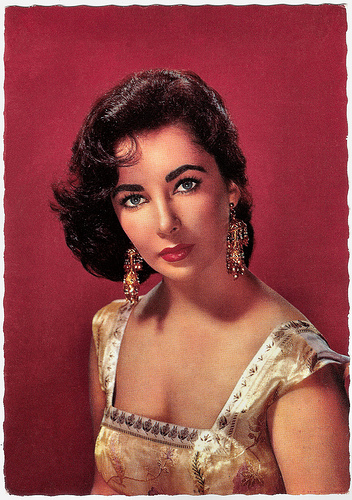
French postcard by E.D.U.G., no. 98.
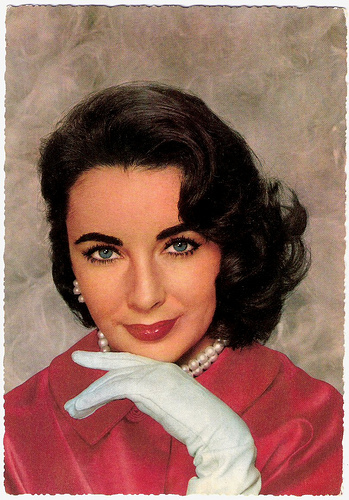
German postcard by Krüger, no. 902/20.
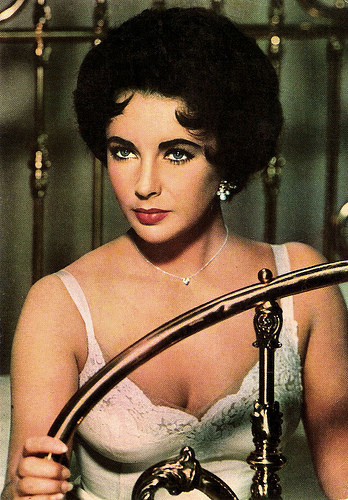
French postcard by E.D.U.G., no. 37. Photo: publicity still for Cat on a Hot Tin Roof (Richard Brooks, 1958).
A dual citizen
Elizabeth Rosemond Taylor was born in 1932 in Hampstead Garden, a northwestern suburb of London. She was the daughter of Francis Lenn Taylor and Sara Sothern, who were United States citizens residing in England. Her father was an art dealer, and her mother was a former stage actress. So Liz was a dual citizen of the United Kingdom and the United States, born British through her birth on British soil and a US citizen through her parents.
At the age of three, Taylor began taking ballet lessons. Shortly before the beginning of World War II, her parents decided to return to the United States. They settled in Los Angeles, California, where her father established a new art gallery, which included many paintings he shipped from England. The gallery soon attracted numerous Hollywood celebrities who appreciated its modern European paintings.
Universal Pictures gave the little, but already breathtakingly beautiful Taylor a seven-year contract, and only nine, Elizabeth appeared in her first film, There's One Born Every Minute (Harold Young, 1942). After less than a year, however, the studio fired Taylor for unknown reasons. MGM was searching for an English actress for Lassie Come Home (Fred M. Wilcox, 1943) with child-star Roddy McDowall. Taylor received the role and was offered a long-term contract.
Her first assignment was a loan-out to 20th Century Fox for a film version of the Charlotte Brontë novel Jane Eyre (Robert Stevenson, 1943) with Orson Welles . Taylor returned to England to appear in The White Cliffs of Dover (Clarence Brown, 1944). Taylor's persistence in seeking the role of Velvet Brown in MGM's National Velvet (Clarence Brown, 1944) made her a star at the age of 12. Her character was a young girl, training her beloved horse to win the Grand National. The film costarred Mickey Rooney and English newcomer Angela Lansbury,and became a great success.
Next, she was cast in another animal film, Courage of Lassie (Fred M. Wilcox, 1946). The film's success led to another contract for Taylor paying her $750 per week. Her roles as the neurotic Mary Skinner in a loan-out to Warner Brothers' Life With Father (Michael Curtiz, 1947), Cynthia Bishop in Cynthia (Robert Z. Leonard, 1947), Carol Pringle in A Date with Judy (Richard Thorpe, 1948), and Susan Prackett in Julia Misbehaves (Jack Conway, 1948) were all successful. Taylor earned a reputation as a consistently successful adolescent actress, with a promising career. Her portrayal of Amy in the American classic Little Women (Mervyn LeRoy, 1949) was her last adolescent role.
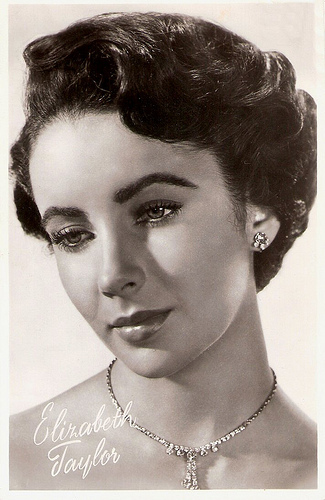
Dutch postcard. Photo: MGM.
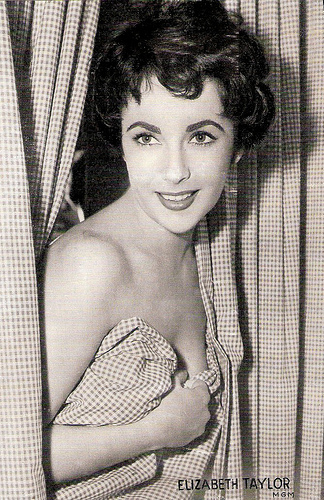
Dutch postcard. Photo: MGM.
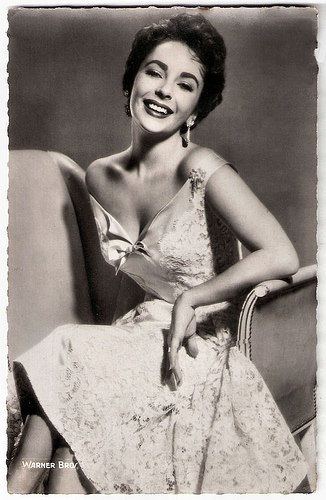
French postcard by Editions du Globe, no. 524. Photo: Warner Bros.
An easy transition to adult roles
In October 1948, Elizabeth Taylor sailed to England to film Conspirator (1949). Taylor made an easy transition to adult roles. Conspirator failed at the box office, but 16-year-old Taylor's portrayal of a 21-year-old debutante who unknowingly marries a communist spy, was praised by critics for her first adult lead in a film. Her first box office success in an adult role came as Kay Banks in the comedy Father of the Bride (Vincente Minnelli, 1950), alongside Spencer Tracy. The film spawned a sequel, Father's Little Dividend (Vincente Minnelli, 1951), which also did well at the box office, but it would be Taylor's next picture that would set the course for her career as a dramatic actress.
For her performance in A Place in the Sun (George Stevens, 1951), Taylor was hailed. She played Angela Vickers, a spoiled socialite who comes between George Eastman (Montgomery Clift) and his poor, pregnant factory-working girlfriend Alice Tripp (Shelley Winters). The film was based on Theodore Dreiser's novel An American Tragedy. Critic A.H. Weiler wrote in The New York Times: "Elizabeth's delineation of the rich and beauteous Angela is the top effort of her career".
After some disappointingly run-of-the-mill films, a more substantial role followed opposite Rock Hudson and James Dean in the epic Giant (George Stevens, 1956). Taylor was nominated for an Academy Award for Best Actress four years in a row for Raintree County (Edward Dmytryk, 1957) opposite Montgomery Clift; Cat on a Hot Tin Roof (Richard Brooks, 1958) opposite Paul Newman; Suddenly, Last Summer (Joseph L. Mankiewicz, 1959) with Montgomery Clift and Katharine Hepburn; and finally winning for BUtterfield 8 (Daniel Mann, 1960). The film co-starred Laurence Harvey and her then-husband Eddie Fisher. Suddenly, Last Summer's success placed Taylor among the box-office top-ten, and she remained there almost every year for the next decade.
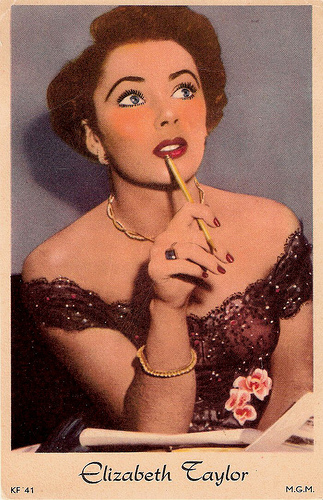
Dutch postcard by Filmphoto Service, Amsterdam, no. KF 41. Photo: MGM.
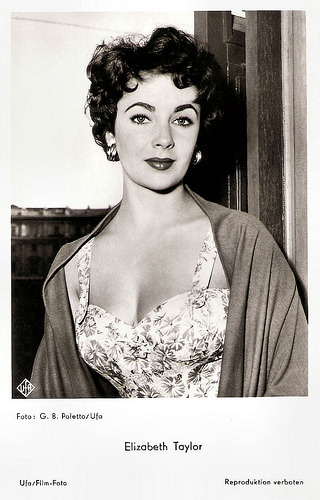
German postcard by Ufa, Berlin-Tempelhof, no. FK 3515. Photo: G.B. Poletto / Ufa.
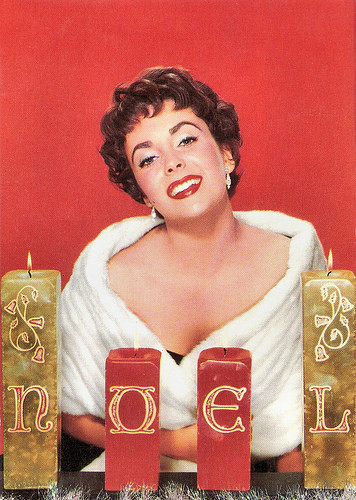
French postcard by Editions P.I., Paris, no. 1051. Photo: John Everton / Ufa.
Cleopatra
In 1960, Elizabeth Taylor became the highest-paid actor in Hollywood when she signed a $1 million dollar contract to play the title role in 20th Century Fox's lavish production of Cleopatra (Joseph L. Mankiewicz, 1963). During the filming, she began a romance with her future husband Richard Burton , who played Mark Antony in the film. The romance received much attention from the tabloid press, as both were married at the time. Taylor ultimately received $7 million for her role.
Her second Academy Award, also for Best Actress in a Leading Role, was for her performance as Martha in Who's Afraid of Virginia Woolf? (Mike Nichols, 1966), playing opposite then-husband Richard Burton . Taylor saw the film as her chance to really act, because her character was to be twenty years older. She added gray hairs and transformed herself both physically and vocally: she intentionally gained weight, minimized makeup, and added excessive mascara to her eyes along with smudgy bags beneath them.
Taylor and Burton appeared together in six other films during the decade, among them The V.I.P.s (Anthony Asquith, 1963), The Sandpiper (Vincente Minnelli, 1965), and The Taming of the Shrew (Franco Zeffirelli, 1967). By 1967 their films had earned $200 million at the box office. Their next films Doctor Faustus (Richard Burton, Nevill Coghill, 1967), The Comedians (Peter Glenville, 1967) and Boom! (Joseph Losey, 1968), however, all failed at the box office.
Taylor appeared in John Huston's Reflections in a Golden Eye (1967) opposite Marlon Brando and Secret Ceremony (Joseph Losey, 1968) opposite Mia Farrow. By the end of the decade her box-office drawing power had considerably diminished, as evidenced by the failure of The Only Game in Town (George Stevens, 1970), with Warren Beatty.
Throughout the 1970s, Taylor continued to star in numerous theatrical films, such as Zee and Co. (Brian G. Hutton, 1972) with Michael Caine , Ash Wednesday (Larry Peerce, 1973), The Blue Bird (George Cukor, 1976) with Jane Fonda and Ava Gardner , and A Little Night Music (Harold Prince, 1977). With Richard Burton , she co-starred in Under Milk Wood (Andrew Sinclair, 1972) and Hammersmith Is Out (Peter Ustinov, 1972).

British postcard in the Picturegoer Series, London, no. D 903. Photo: Warner Bros. Publicity still for Giant (George Stevens, 1956) with James Dean.
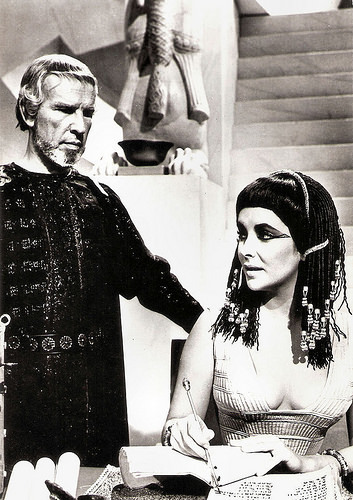
Czech postcard by UPF, Praha / Press Photo. Photo: publicity still for Cleopatra (Joseph L. Mankiewicz, 1963) with Hume Cronyn.
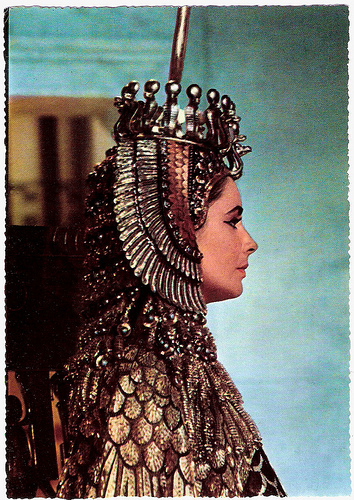
Belgian postcard by SB (Uitgeverij Best), Antwerpen (Antwerp). Photo: still for Cleopatra (Joseph L. Mankiewicz, 1963).
Malice in Wonderland
In 1980, Elizabeth Taylor starred in the mystery film The Mirror Crack'd (Guy Hamilton, 1980), based on an Agatha Christie novel. In 1985, she played movie gossip columnist Louella Parsons in the TV film Malice in Wonderland (Gus Trikonis, 1985) opposite Jane Alexander, who played Hedda Hopper. Taylor appeared in the miniseries North and South (Richard T. Heffron, 1985) and her last theatrical film was The Flintstones (Brian Levant, 1994).
Taylor also acted on the stage, making her Broadway and West End debuts in 1982 with a revival of Lillian Hellman's The Little Foxes. She was then in a production of Noël Coward's Private Lives (1983), in which she starred with her former husband, Richard Burton . The student-run Burton Taylor Studio in Oxford was named for the famous couple after Burton appeared as Doctor Faustus in the Oxford University Dramatic Society production of the Marlowe play. Taylor played the ghostly, wordless Helen of Troy, who is entreated by Faustus to make him immortal with a kiss.
In 2007, Taylor acted onstage again, appearing opposite James Earl Jones in a benefit performance of the A. R. Gurney play Love Letters. The event's goal was to raise $1 million for Taylor's AIDS foundation. Tickets for the show were priced at $2,500, and more than 500 people attended. The event happened to coincide with the 2007 Writers Guild of America strike and, rather than cross the picket line, Taylor requested a "one night dispensation". The Writers Guild agreed not to picket the Paramount Pictures lot that night to allow for the performance.
In the early 1980s, Elizabeth Taylor had moved to Bel Air, California, which was her residence until her death. Taylor was married eight times to seven husbands, including actor Michael Wilding, producer Michael Todd, singer-actor Eddie Fisher and Richard Burton, whom she married twice. In 2011, she died at the age of 79 in Los Angeles, surrounded by her four children.
Trailer Suddenly, Last Summer (1959). Source: dameelizabethtaylor (YouTube).
Trailer Cleopatra (1963). Source: dameelizabethtaylor (YouTube).
Trailer Boom! (1968). Source: DVDFilmFun (YouTube).
Sources: Wikipedia and .

French postcard by E.D.U.G., no. 98.

German postcard by Krüger, no. 902/20.

French postcard by E.D.U.G., no. 37. Photo: publicity still for Cat on a Hot Tin Roof (Richard Brooks, 1958).
A dual citizen
Elizabeth Rosemond Taylor was born in 1932 in Hampstead Garden, a northwestern suburb of London. She was the daughter of Francis Lenn Taylor and Sara Sothern, who were United States citizens residing in England. Her father was an art dealer, and her mother was a former stage actress. So Liz was a dual citizen of the United Kingdom and the United States, born British through her birth on British soil and a US citizen through her parents.
At the age of three, Taylor began taking ballet lessons. Shortly before the beginning of World War II, her parents decided to return to the United States. They settled in Los Angeles, California, where her father established a new art gallery, which included many paintings he shipped from England. The gallery soon attracted numerous Hollywood celebrities who appreciated its modern European paintings.
Universal Pictures gave the little, but already breathtakingly beautiful Taylor a seven-year contract, and only nine, Elizabeth appeared in her first film, There's One Born Every Minute (Harold Young, 1942). After less than a year, however, the studio fired Taylor for unknown reasons. MGM was searching for an English actress for Lassie Come Home (Fred M. Wilcox, 1943) with child-star Roddy McDowall. Taylor received the role and was offered a long-term contract.
Her first assignment was a loan-out to 20th Century Fox for a film version of the Charlotte Brontë novel Jane Eyre (Robert Stevenson, 1943) with Orson Welles . Taylor returned to England to appear in The White Cliffs of Dover (Clarence Brown, 1944). Taylor's persistence in seeking the role of Velvet Brown in MGM's National Velvet (Clarence Brown, 1944) made her a star at the age of 12. Her character was a young girl, training her beloved horse to win the Grand National. The film costarred Mickey Rooney and English newcomer Angela Lansbury,and became a great success.
Next, she was cast in another animal film, Courage of Lassie (Fred M. Wilcox, 1946). The film's success led to another contract for Taylor paying her $750 per week. Her roles as the neurotic Mary Skinner in a loan-out to Warner Brothers' Life With Father (Michael Curtiz, 1947), Cynthia Bishop in Cynthia (Robert Z. Leonard, 1947), Carol Pringle in A Date with Judy (Richard Thorpe, 1948), and Susan Prackett in Julia Misbehaves (Jack Conway, 1948) were all successful. Taylor earned a reputation as a consistently successful adolescent actress, with a promising career. Her portrayal of Amy in the American classic Little Women (Mervyn LeRoy, 1949) was her last adolescent role.

Dutch postcard. Photo: MGM.

Dutch postcard. Photo: MGM.

French postcard by Editions du Globe, no. 524. Photo: Warner Bros.
An easy transition to adult roles
In October 1948, Elizabeth Taylor sailed to England to film Conspirator (1949). Taylor made an easy transition to adult roles. Conspirator failed at the box office, but 16-year-old Taylor's portrayal of a 21-year-old debutante who unknowingly marries a communist spy, was praised by critics for her first adult lead in a film. Her first box office success in an adult role came as Kay Banks in the comedy Father of the Bride (Vincente Minnelli, 1950), alongside Spencer Tracy. The film spawned a sequel, Father's Little Dividend (Vincente Minnelli, 1951), which also did well at the box office, but it would be Taylor's next picture that would set the course for her career as a dramatic actress.
For her performance in A Place in the Sun (George Stevens, 1951), Taylor was hailed. She played Angela Vickers, a spoiled socialite who comes between George Eastman (Montgomery Clift) and his poor, pregnant factory-working girlfriend Alice Tripp (Shelley Winters). The film was based on Theodore Dreiser's novel An American Tragedy. Critic A.H. Weiler wrote in The New York Times: "Elizabeth's delineation of the rich and beauteous Angela is the top effort of her career".
After some disappointingly run-of-the-mill films, a more substantial role followed opposite Rock Hudson and James Dean in the epic Giant (George Stevens, 1956). Taylor was nominated for an Academy Award for Best Actress four years in a row for Raintree County (Edward Dmytryk, 1957) opposite Montgomery Clift; Cat on a Hot Tin Roof (Richard Brooks, 1958) opposite Paul Newman; Suddenly, Last Summer (Joseph L. Mankiewicz, 1959) with Montgomery Clift and Katharine Hepburn; and finally winning for BUtterfield 8 (Daniel Mann, 1960). The film co-starred Laurence Harvey and her then-husband Eddie Fisher. Suddenly, Last Summer's success placed Taylor among the box-office top-ten, and she remained there almost every year for the next decade.

Dutch postcard by Filmphoto Service, Amsterdam, no. KF 41. Photo: MGM.

German postcard by Ufa, Berlin-Tempelhof, no. FK 3515. Photo: G.B. Poletto / Ufa.

French postcard by Editions P.I., Paris, no. 1051. Photo: John Everton / Ufa.
Cleopatra
In 1960, Elizabeth Taylor became the highest-paid actor in Hollywood when she signed a $1 million dollar contract to play the title role in 20th Century Fox's lavish production of Cleopatra (Joseph L. Mankiewicz, 1963). During the filming, she began a romance with her future husband Richard Burton , who played Mark Antony in the film. The romance received much attention from the tabloid press, as both were married at the time. Taylor ultimately received $7 million for her role.
Her second Academy Award, also for Best Actress in a Leading Role, was for her performance as Martha in Who's Afraid of Virginia Woolf? (Mike Nichols, 1966), playing opposite then-husband Richard Burton . Taylor saw the film as her chance to really act, because her character was to be twenty years older. She added gray hairs and transformed herself both physically and vocally: she intentionally gained weight, minimized makeup, and added excessive mascara to her eyes along with smudgy bags beneath them.
Taylor and Burton appeared together in six other films during the decade, among them The V.I.P.s (Anthony Asquith, 1963), The Sandpiper (Vincente Minnelli, 1965), and The Taming of the Shrew (Franco Zeffirelli, 1967). By 1967 their films had earned $200 million at the box office. Their next films Doctor Faustus (Richard Burton, Nevill Coghill, 1967), The Comedians (Peter Glenville, 1967) and Boom! (Joseph Losey, 1968), however, all failed at the box office.
Taylor appeared in John Huston's Reflections in a Golden Eye (1967) opposite Marlon Brando and Secret Ceremony (Joseph Losey, 1968) opposite Mia Farrow. By the end of the decade her box-office drawing power had considerably diminished, as evidenced by the failure of The Only Game in Town (George Stevens, 1970), with Warren Beatty.
Throughout the 1970s, Taylor continued to star in numerous theatrical films, such as Zee and Co. (Brian G. Hutton, 1972) with Michael Caine , Ash Wednesday (Larry Peerce, 1973), The Blue Bird (George Cukor, 1976) with Jane Fonda and Ava Gardner , and A Little Night Music (Harold Prince, 1977). With Richard Burton , she co-starred in Under Milk Wood (Andrew Sinclair, 1972) and Hammersmith Is Out (Peter Ustinov, 1972).

British postcard in the Picturegoer Series, London, no. D 903. Photo: Warner Bros. Publicity still for Giant (George Stevens, 1956) with James Dean.

Czech postcard by UPF, Praha / Press Photo. Photo: publicity still for Cleopatra (Joseph L. Mankiewicz, 1963) with Hume Cronyn.

Belgian postcard by SB (Uitgeverij Best), Antwerpen (Antwerp). Photo: still for Cleopatra (Joseph L. Mankiewicz, 1963).
Malice in Wonderland
In 1980, Elizabeth Taylor starred in the mystery film The Mirror Crack'd (Guy Hamilton, 1980), based on an Agatha Christie novel. In 1985, she played movie gossip columnist Louella Parsons in the TV film Malice in Wonderland (Gus Trikonis, 1985) opposite Jane Alexander, who played Hedda Hopper. Taylor appeared in the miniseries North and South (Richard T. Heffron, 1985) and her last theatrical film was The Flintstones (Brian Levant, 1994).
Taylor also acted on the stage, making her Broadway and West End debuts in 1982 with a revival of Lillian Hellman's The Little Foxes. She was then in a production of Noël Coward's Private Lives (1983), in which she starred with her former husband, Richard Burton . The student-run Burton Taylor Studio in Oxford was named for the famous couple after Burton appeared as Doctor Faustus in the Oxford University Dramatic Society production of the Marlowe play. Taylor played the ghostly, wordless Helen of Troy, who is entreated by Faustus to make him immortal with a kiss.
In 2007, Taylor acted onstage again, appearing opposite James Earl Jones in a benefit performance of the A. R. Gurney play Love Letters. The event's goal was to raise $1 million for Taylor's AIDS foundation. Tickets for the show were priced at $2,500, and more than 500 people attended. The event happened to coincide with the 2007 Writers Guild of America strike and, rather than cross the picket line, Taylor requested a "one night dispensation". The Writers Guild agreed not to picket the Paramount Pictures lot that night to allow for the performance.
In the early 1980s, Elizabeth Taylor had moved to Bel Air, California, which was her residence until her death. Taylor was married eight times to seven husbands, including actor Michael Wilding, producer Michael Todd, singer-actor Eddie Fisher and Richard Burton, whom she married twice. In 2011, she died at the age of 79 in Los Angeles, surrounded by her four children.
Trailer Suddenly, Last Summer (1959). Source: dameelizabethtaylor (YouTube).
Trailer Cleopatra (1963). Source: dameelizabethtaylor (YouTube).
Trailer Boom! (1968). Source: DVDFilmFun (YouTube).
Sources: Wikipedia and .
Published on October 16, 2015 22:00
October 15, 2015
EFSP's Dazzling Dozen: A Star's Best Friend
New series alert! During our trip to the Pordenone Silent Film Festival earlier this month, we did a post on twelve silent cowboys. We hope you liked the idea, because we did. We already imagined dozens of variations - some wild and crazy. But we start this series, which we created especially for Postcard Friendship Friday, with twelve of our favourite postcards of stars with their dogs.
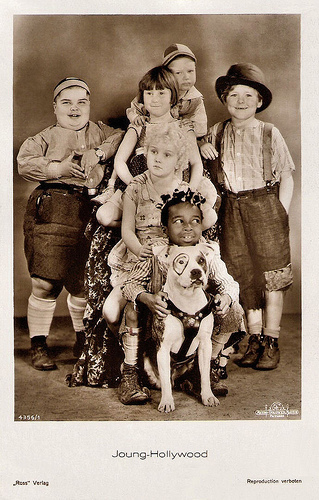
Our Gang. German postcard by Ross Verlag, no. 4356/1, 1929-1930. Photo: Metro-Goldwyn-Mayer.
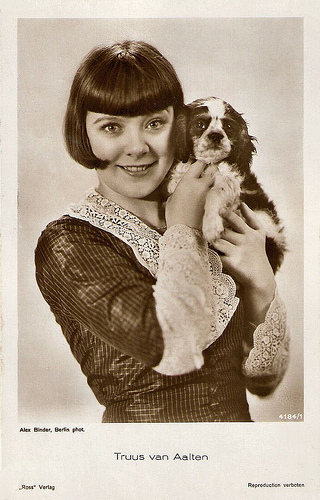
Truus van Aalten . German postcard by Ross Verlag, no. 4184/1, 1929-1930. Photo: Atelier Binder, Berlin.
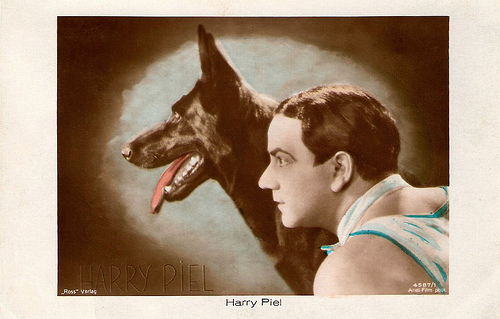
Harry Piel in Sein bester Freund (1929). German postcard by Ross Verlag, Berlin, no. 4587/1, 1929-1930. Photo: Ariel Film.

Jenny Jugo . German postcard by Ross Verlag, no. 6156/3, 1931-1932. Photo: Atelier Binder, Berlin.
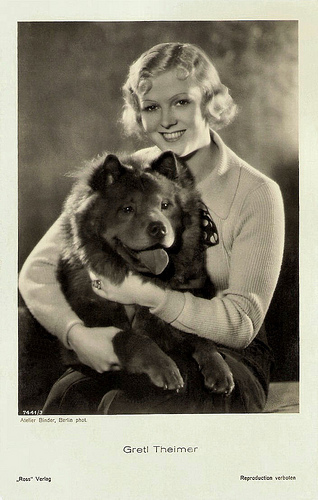
Gretl Theimer . German postcard by Ross Verlag, no. 7441/3, 1932-1933. Photo: Atelier Binder, Berlin.
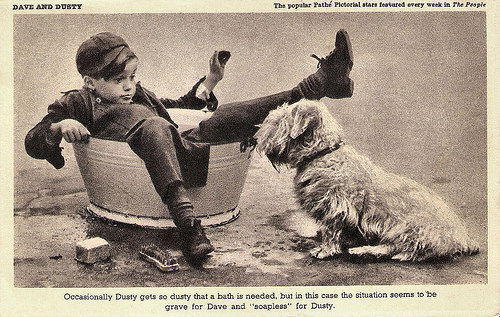
Dave and Dusty . British postcard by Raphael Tuck & Sons. Photo: Pathé Pictorial. Publicity still for Dave and Dusty (1946-1949), a series of short British films chronicling the friendship between a young boy and his shaggy dog. The two friends get into trouble and have various adventures, meeting a host of colourful characters along the way. Raphael Tuck & Sons published a series of black and white postcards of the popular duo, apparently in aid of The Tailwaggers animal charity.
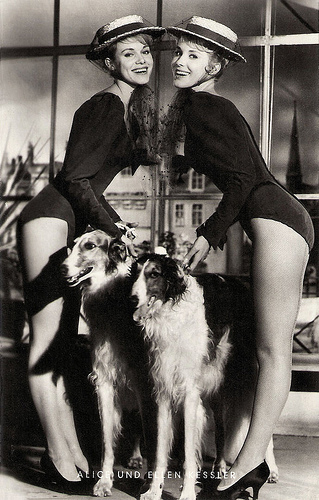
Alice & Ellen Kessler . German postcard by Netter's Star Verlag, Berlin.
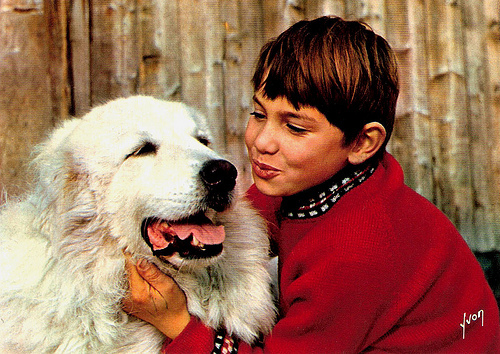
Mehdi El Glaoui. French postcard by Editions d'art Yvon, Paris, no. 6. Photo: RTF / Gaumont. Publicity still for the film Sébastien parmi les hommes (Cécile Aubry, 1968). This is Sébastien and his dog Belle. They were the main characters in the French TV series Belle et Sébastien/Belle and Sebastian (1965) and its sequels Sébastien parmi les hommes (1968) and Sébastien et la Mary-Morgane (1970). The three series were also edited into feature films. Director Cécile Aubry was in the late 1940s and 1950s a shining star of the French cinema. The cute star of her series, Mehdi El Glaoui, was Aubry's own son from her marriage to the pasha of Marrakesh. Belle was played by the dog Yalov.
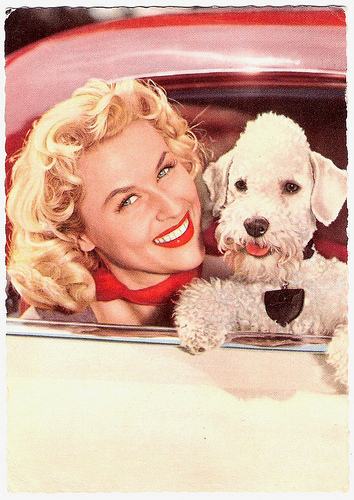
Bibi Johns . German postcard by Universum-Film Aktiengesellschaft (Ufa), Berlin-Tempelhof, no. CK-91. Sent by mail in Germany in 1962. Photo: Arthur Grimm.
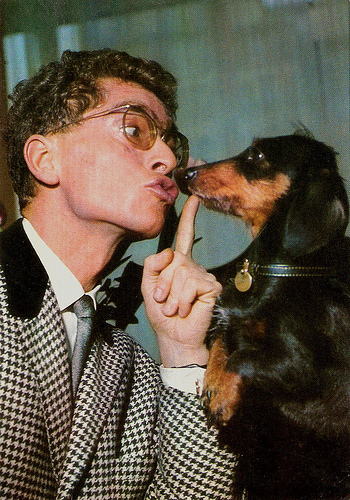
Darry Cowl . French postcard by Ed. Borde, Bal, no. 106. Photo: Wiezniak / Philips.
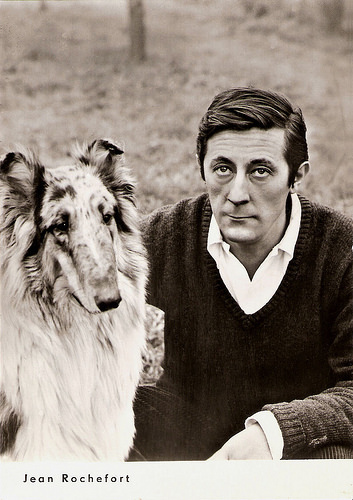
Jean Rochefort . East-German postcard by VEB Progress Film-Vertrieb, Berlin, no. 23/71, 1971. Photo: Unifrance-Film.
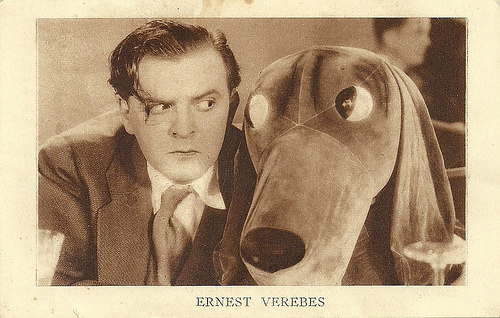
Ernst Verebes. Belgian postcard by S.A. Cacao et Chocolat Kivou, Vilvo[o]rde, Belgium. For either a late silent or early sound film.
This is a post for Postcard Friendship Friday, hosted by Beth at the blog The Best Hearts are Crunchy. You can visit her by clicking on the button below.


Our Gang. German postcard by Ross Verlag, no. 4356/1, 1929-1930. Photo: Metro-Goldwyn-Mayer.

Truus van Aalten . German postcard by Ross Verlag, no. 4184/1, 1929-1930. Photo: Atelier Binder, Berlin.

Harry Piel in Sein bester Freund (1929). German postcard by Ross Verlag, Berlin, no. 4587/1, 1929-1930. Photo: Ariel Film.

Jenny Jugo . German postcard by Ross Verlag, no. 6156/3, 1931-1932. Photo: Atelier Binder, Berlin.

Gretl Theimer . German postcard by Ross Verlag, no. 7441/3, 1932-1933. Photo: Atelier Binder, Berlin.

Dave and Dusty . British postcard by Raphael Tuck & Sons. Photo: Pathé Pictorial. Publicity still for Dave and Dusty (1946-1949), a series of short British films chronicling the friendship between a young boy and his shaggy dog. The two friends get into trouble and have various adventures, meeting a host of colourful characters along the way. Raphael Tuck & Sons published a series of black and white postcards of the popular duo, apparently in aid of The Tailwaggers animal charity.

Alice & Ellen Kessler . German postcard by Netter's Star Verlag, Berlin.

Mehdi El Glaoui. French postcard by Editions d'art Yvon, Paris, no. 6. Photo: RTF / Gaumont. Publicity still for the film Sébastien parmi les hommes (Cécile Aubry, 1968). This is Sébastien and his dog Belle. They were the main characters in the French TV series Belle et Sébastien/Belle and Sebastian (1965) and its sequels Sébastien parmi les hommes (1968) and Sébastien et la Mary-Morgane (1970). The three series were also edited into feature films. Director Cécile Aubry was in the late 1940s and 1950s a shining star of the French cinema. The cute star of her series, Mehdi El Glaoui, was Aubry's own son from her marriage to the pasha of Marrakesh. Belle was played by the dog Yalov.

Bibi Johns . German postcard by Universum-Film Aktiengesellschaft (Ufa), Berlin-Tempelhof, no. CK-91. Sent by mail in Germany in 1962. Photo: Arthur Grimm.

Darry Cowl . French postcard by Ed. Borde, Bal, no. 106. Photo: Wiezniak / Philips.

Jean Rochefort . East-German postcard by VEB Progress Film-Vertrieb, Berlin, no. 23/71, 1971. Photo: Unifrance-Film.

Ernst Verebes. Belgian postcard by S.A. Cacao et Chocolat Kivou, Vilvo[o]rde, Belgium. For either a late silent or early sound film.
This is a post for Postcard Friendship Friday, hosted by Beth at the blog The Best Hearts are Crunchy. You can visit her by clicking on the button below.

Published on October 15, 2015 22:00
Paul van Yperen's Blog
- Paul van Yperen's profile
- 13 followers
Paul van Yperen isn't a Goodreads Author
(yet),
but they
do have a blog,
so here are some recent posts imported from
their feed.



